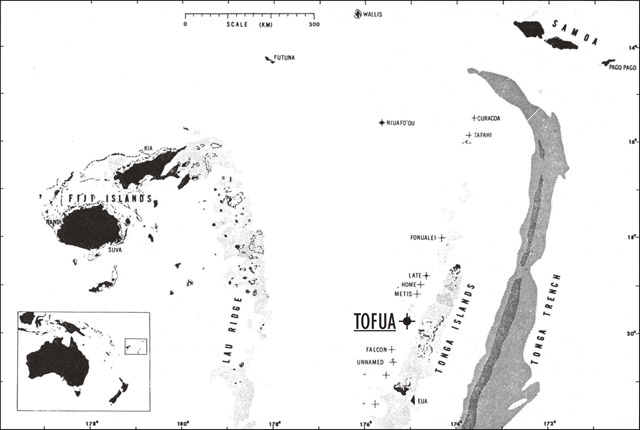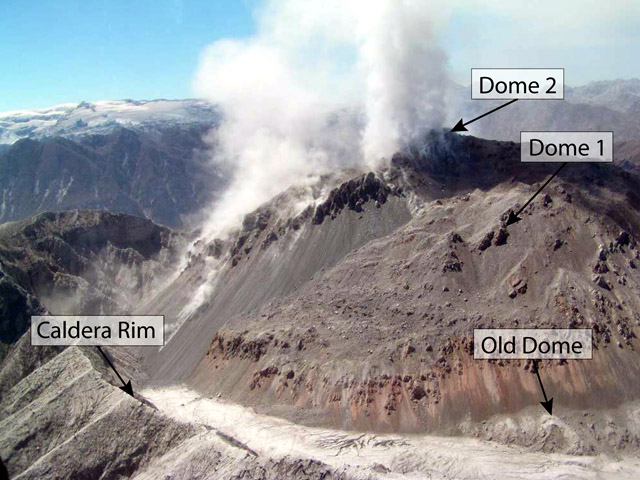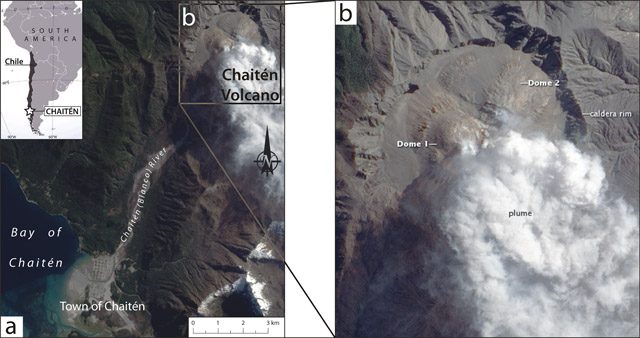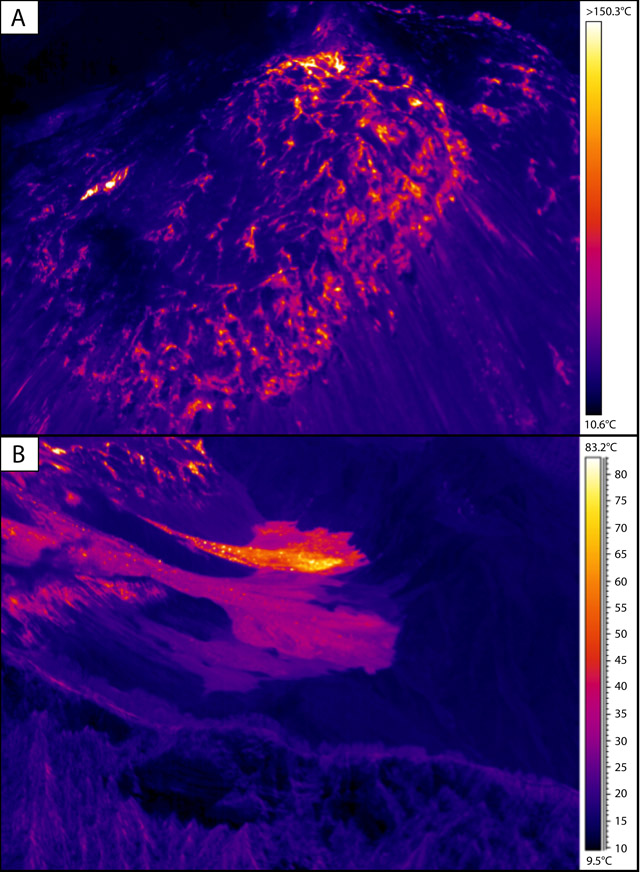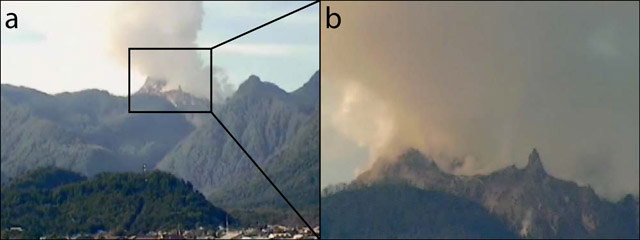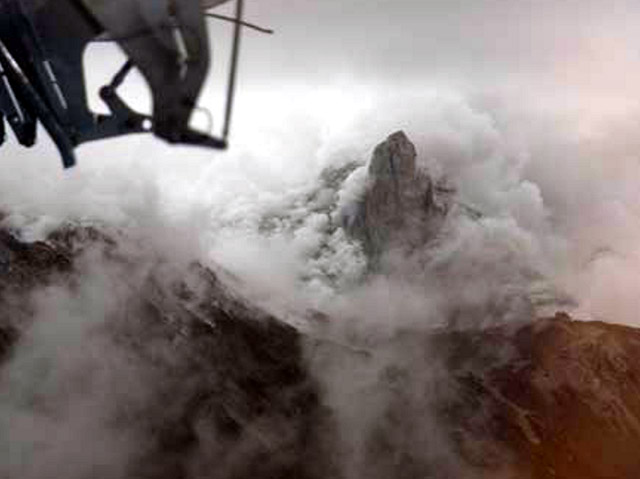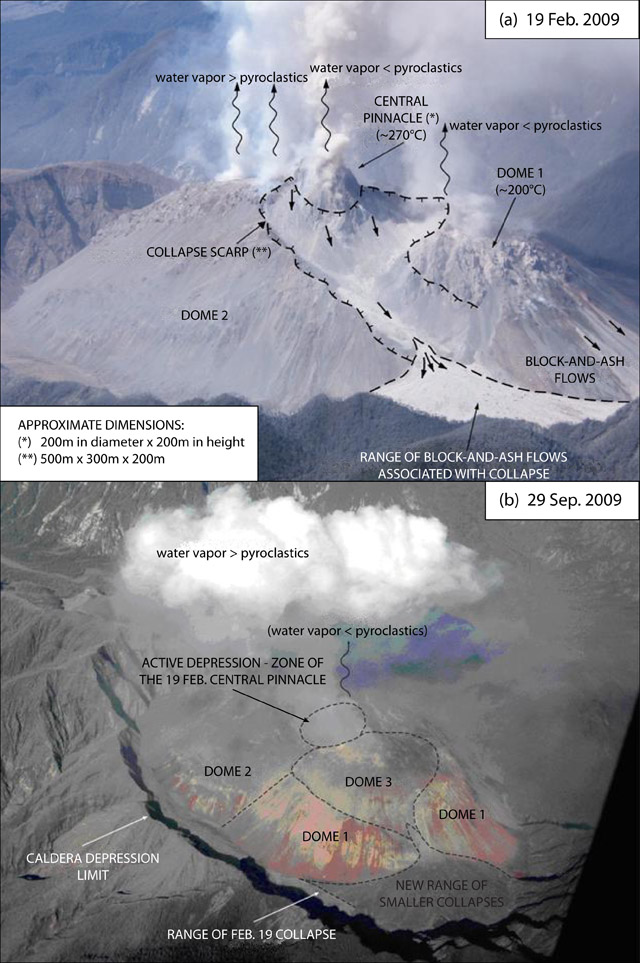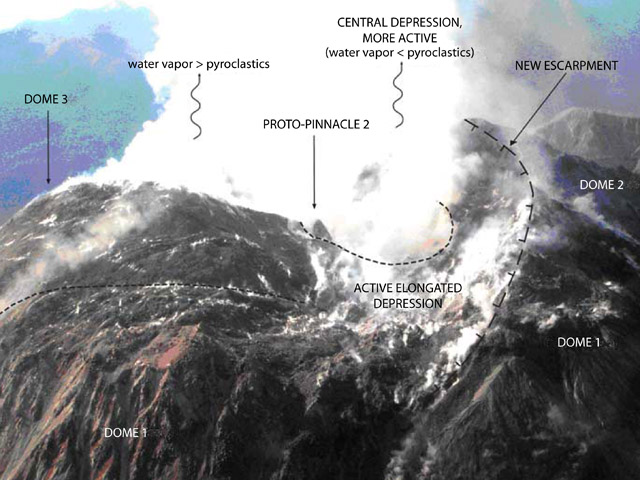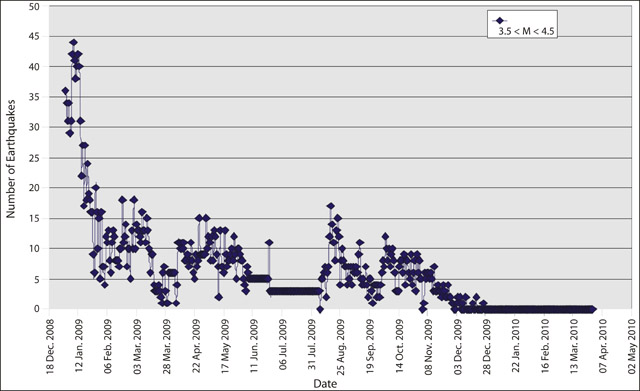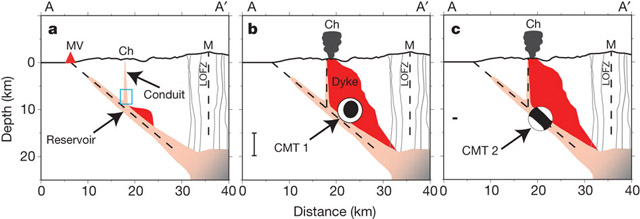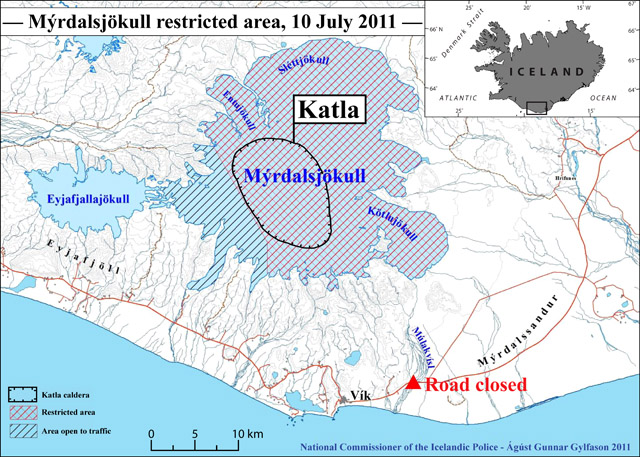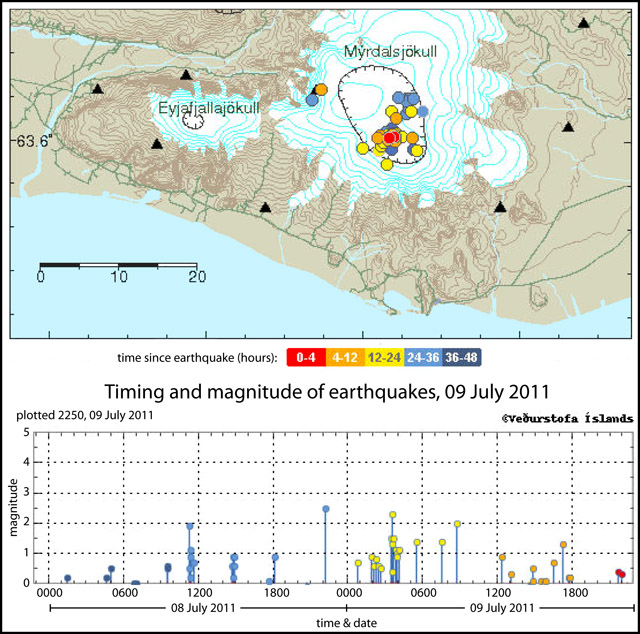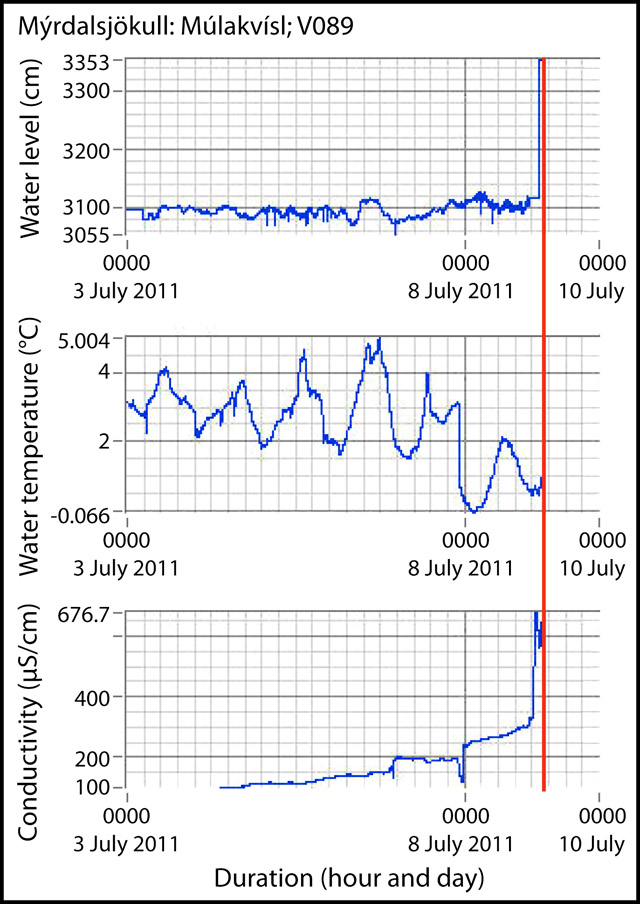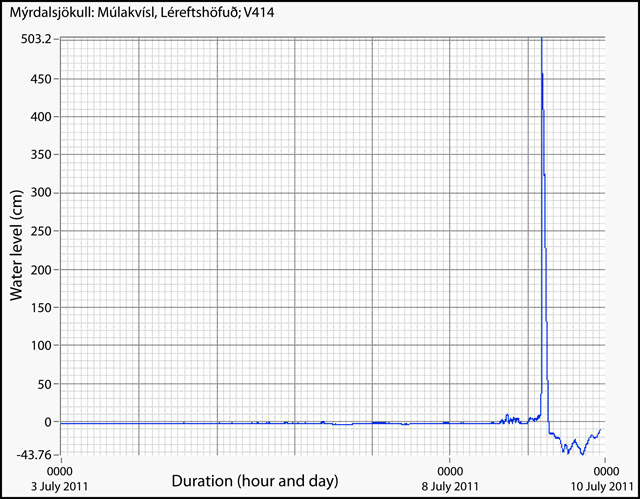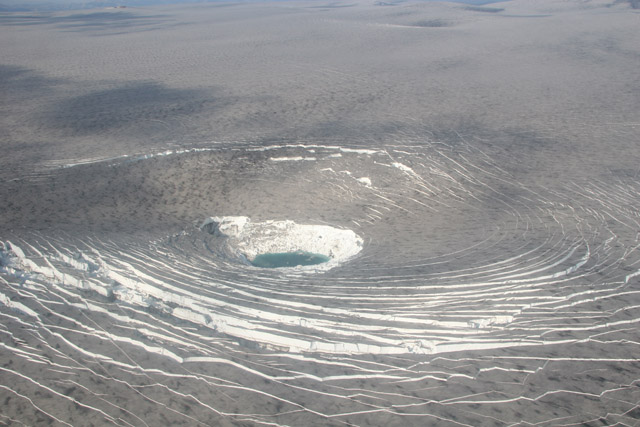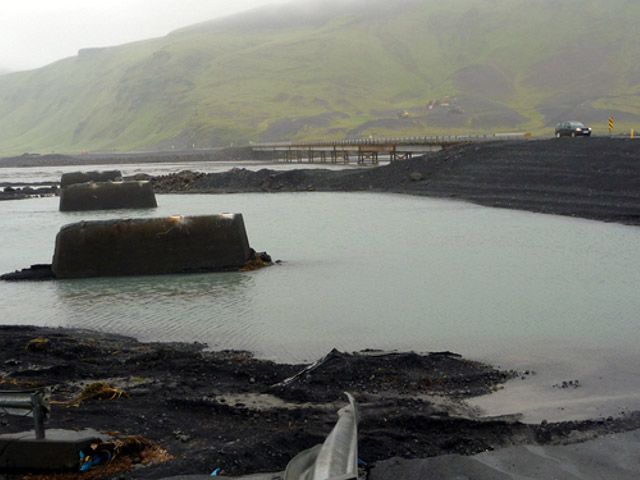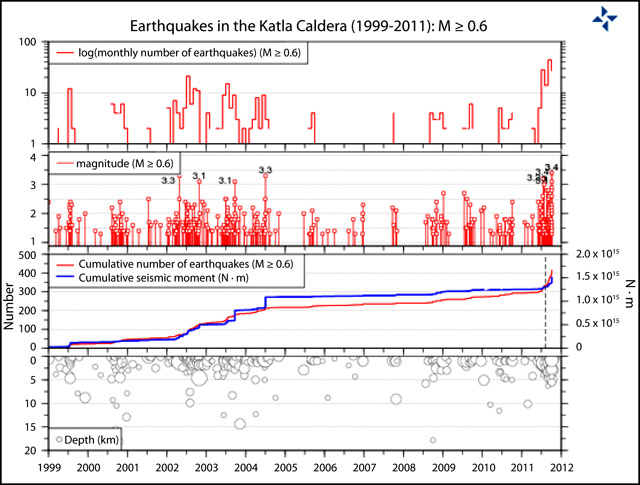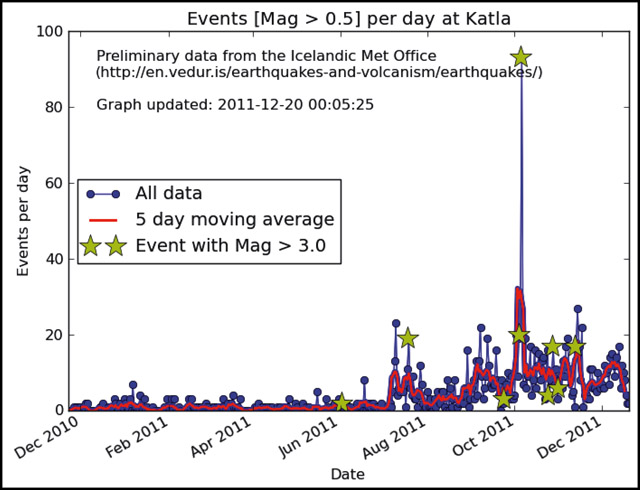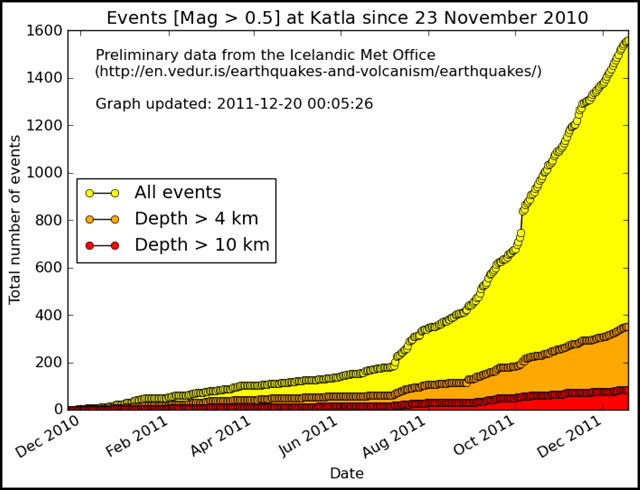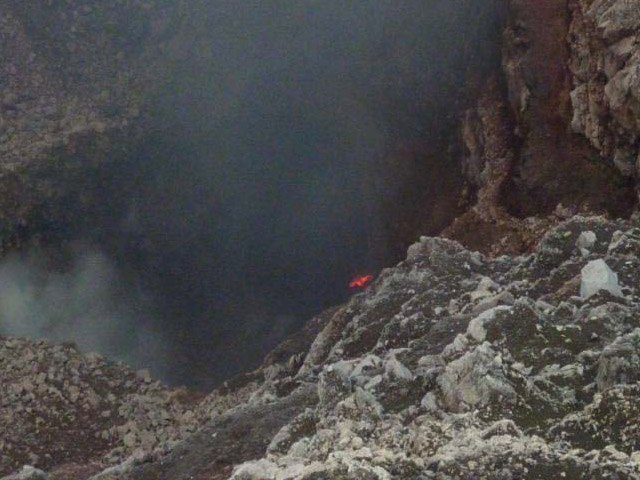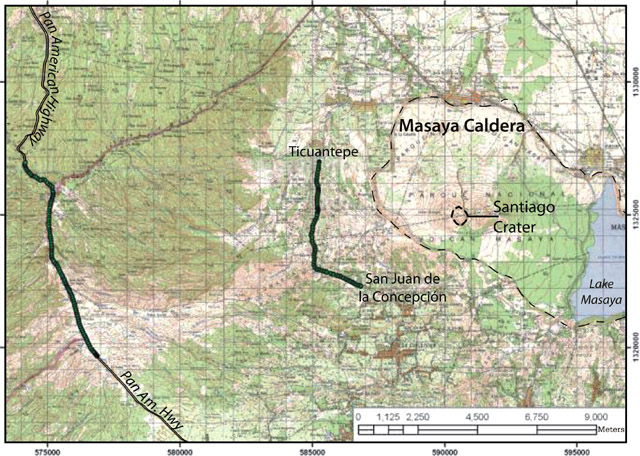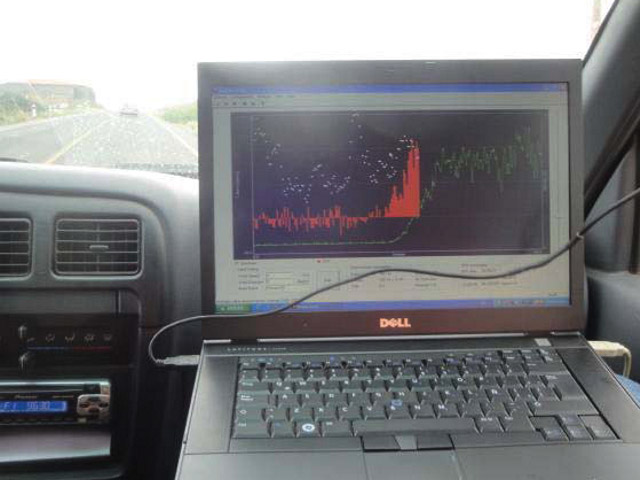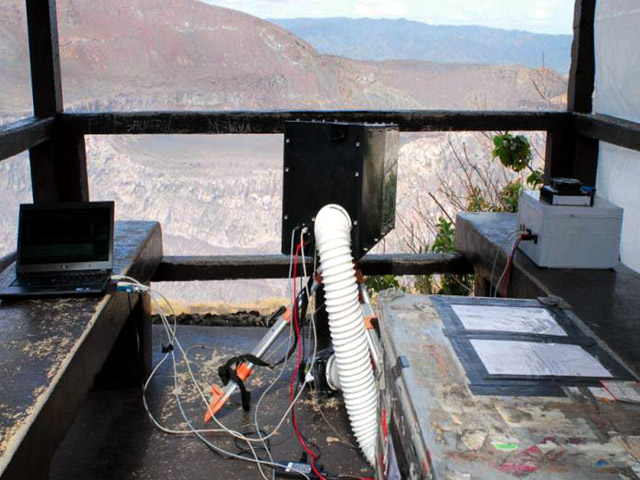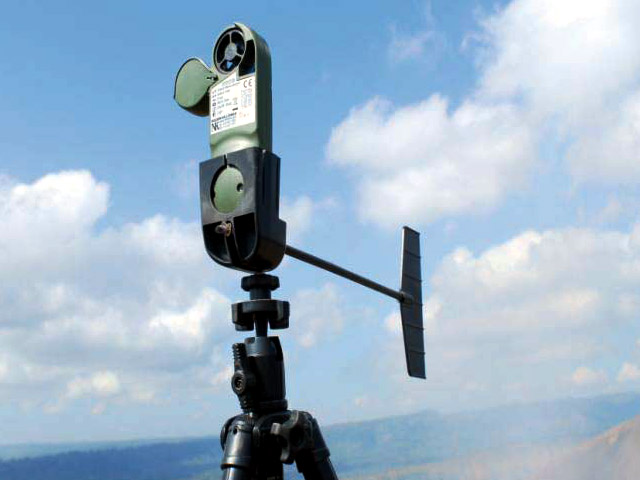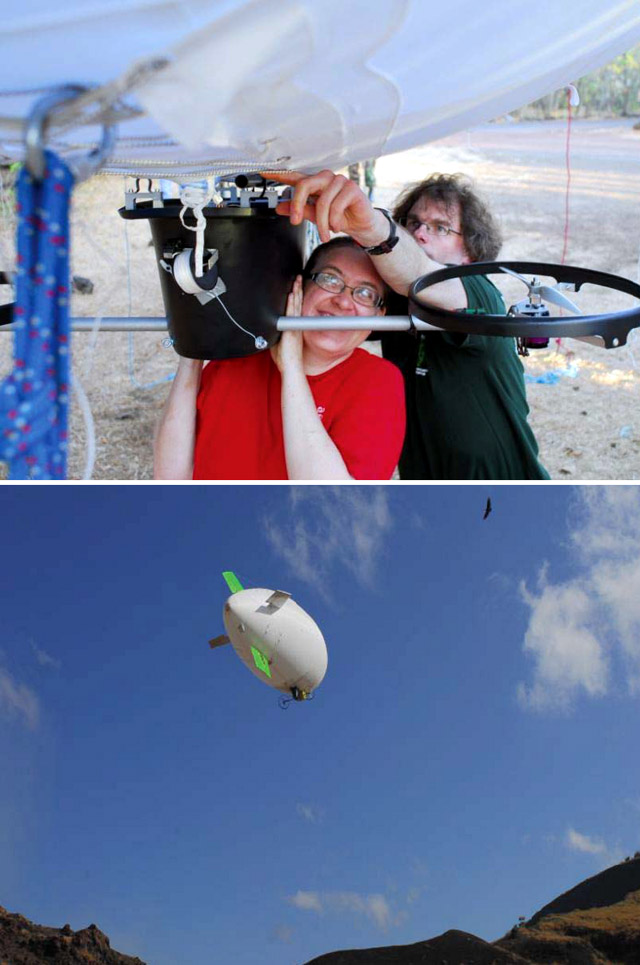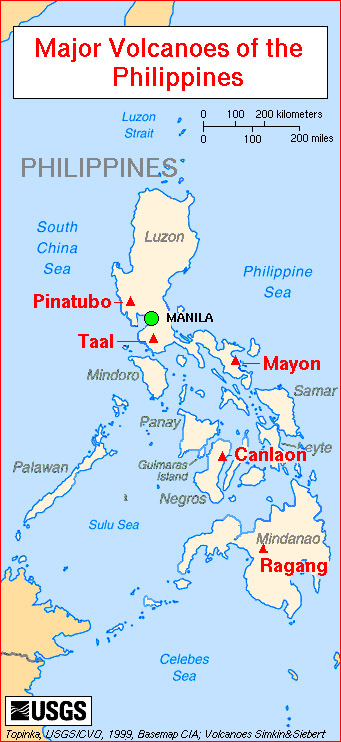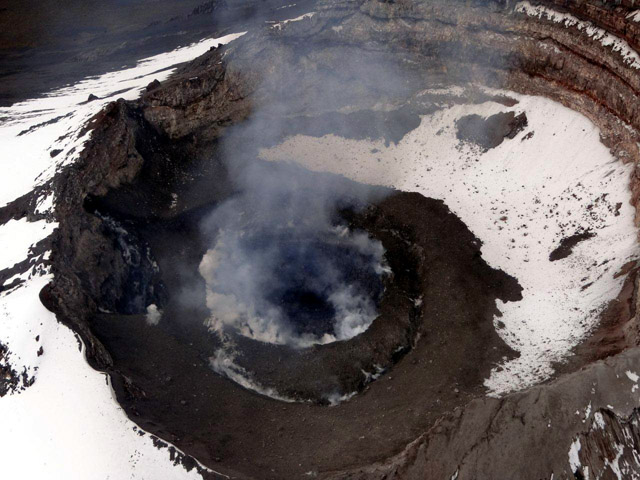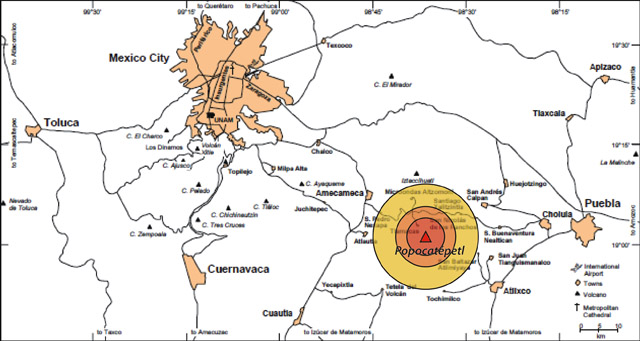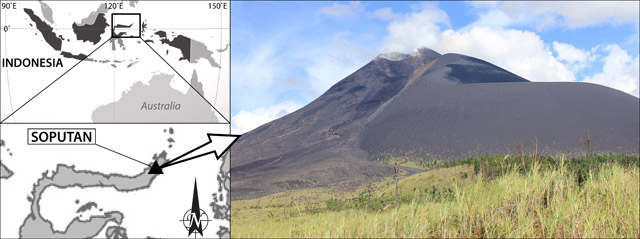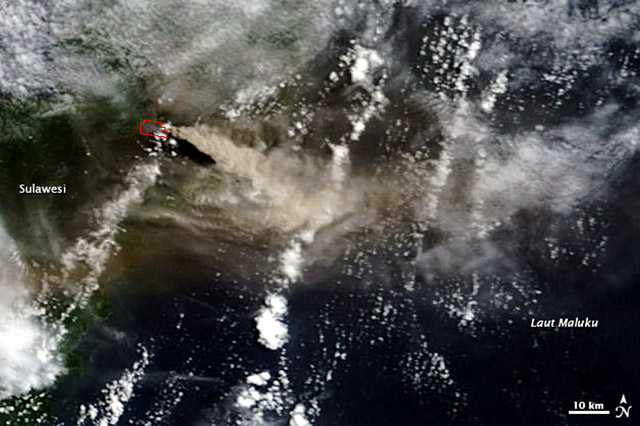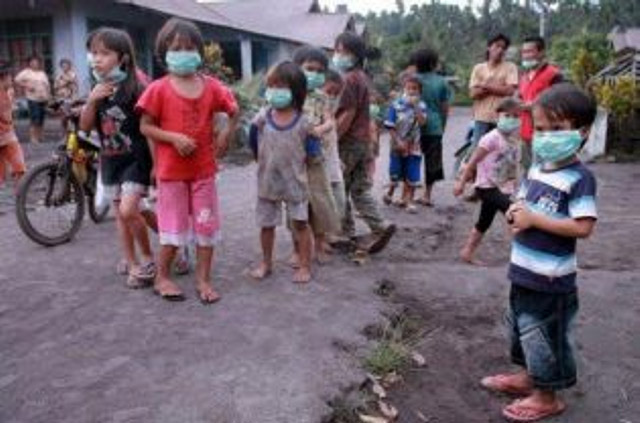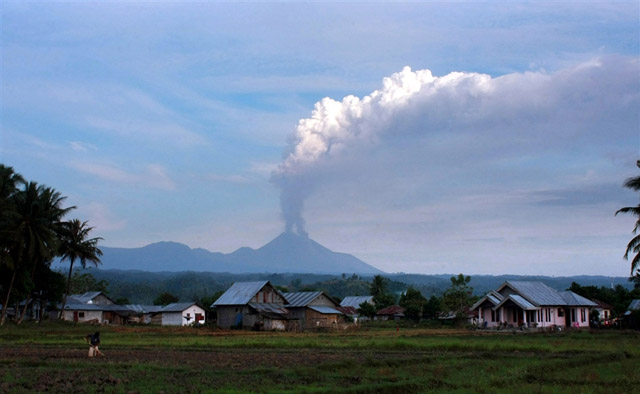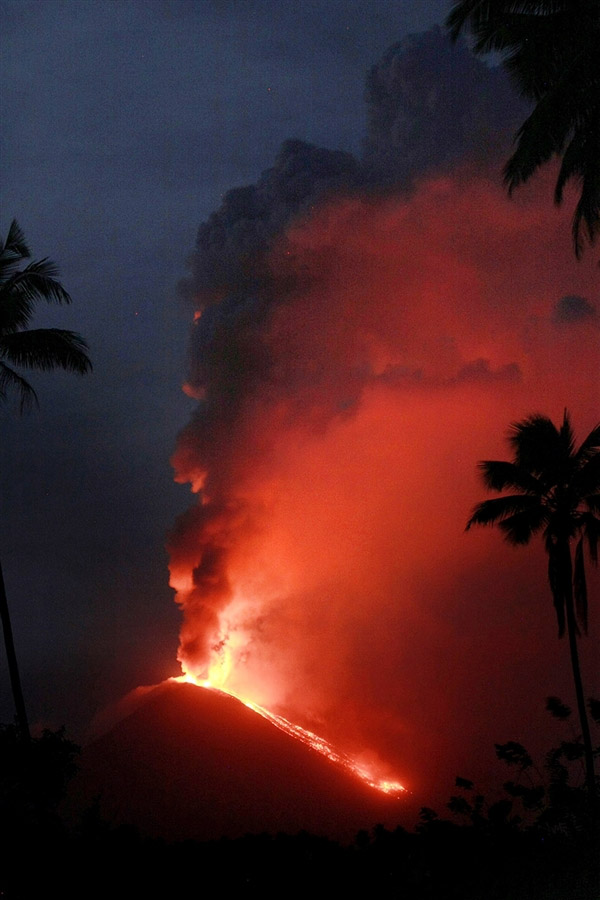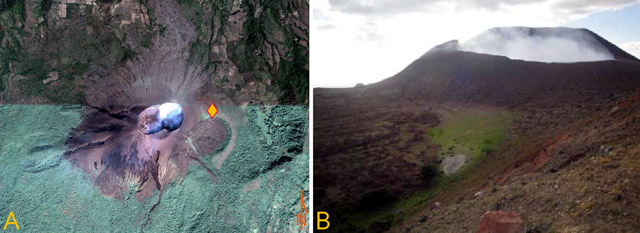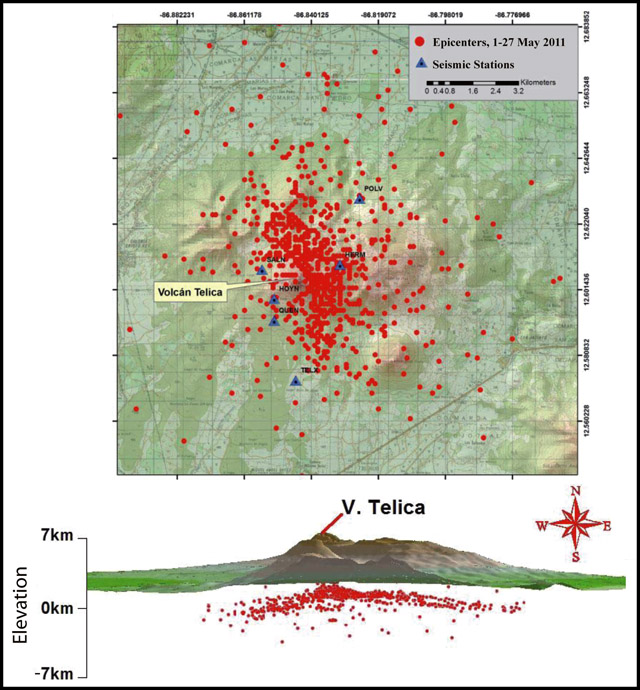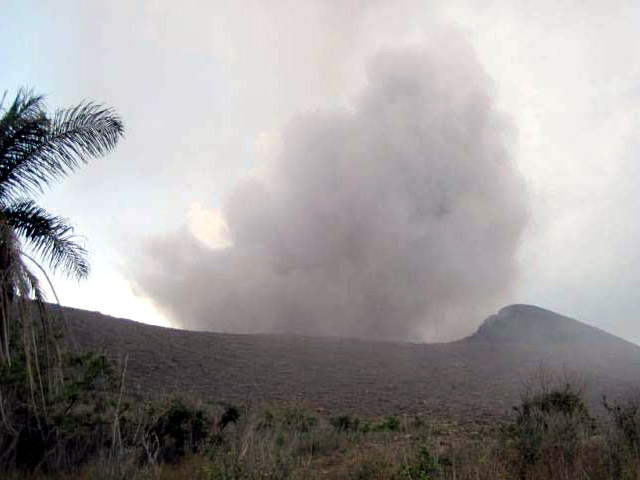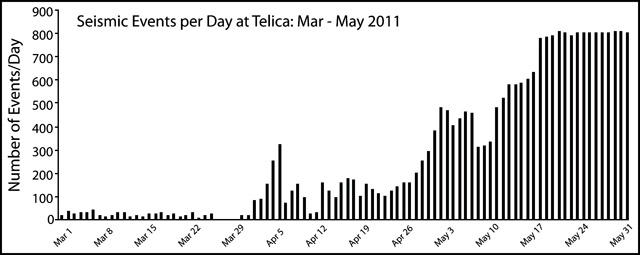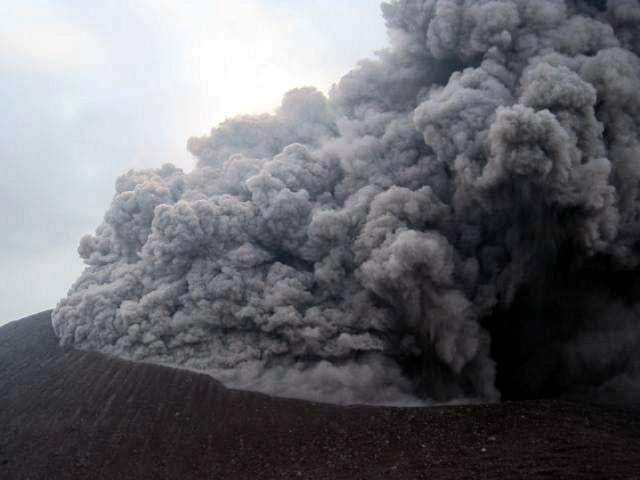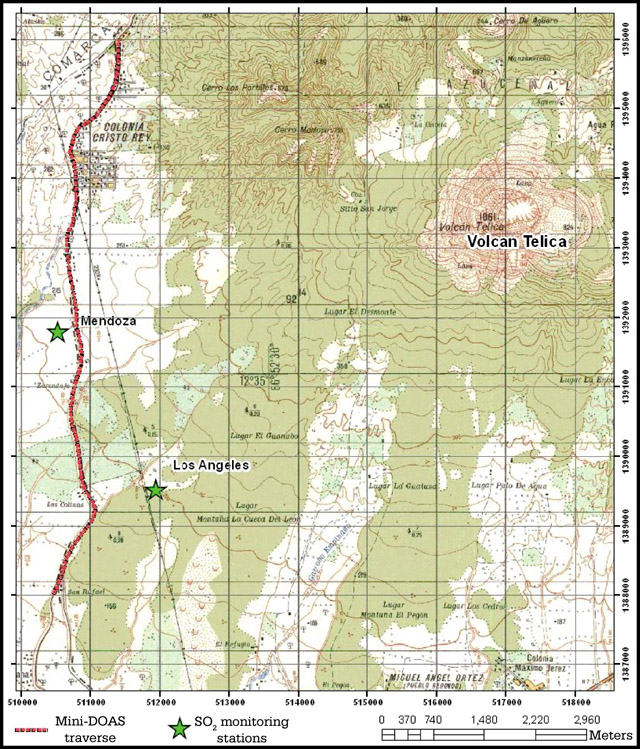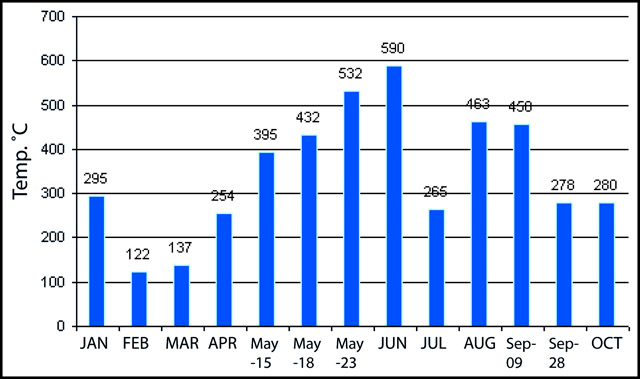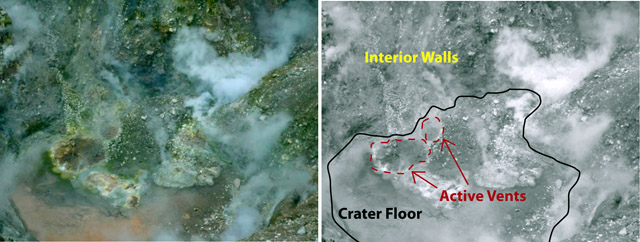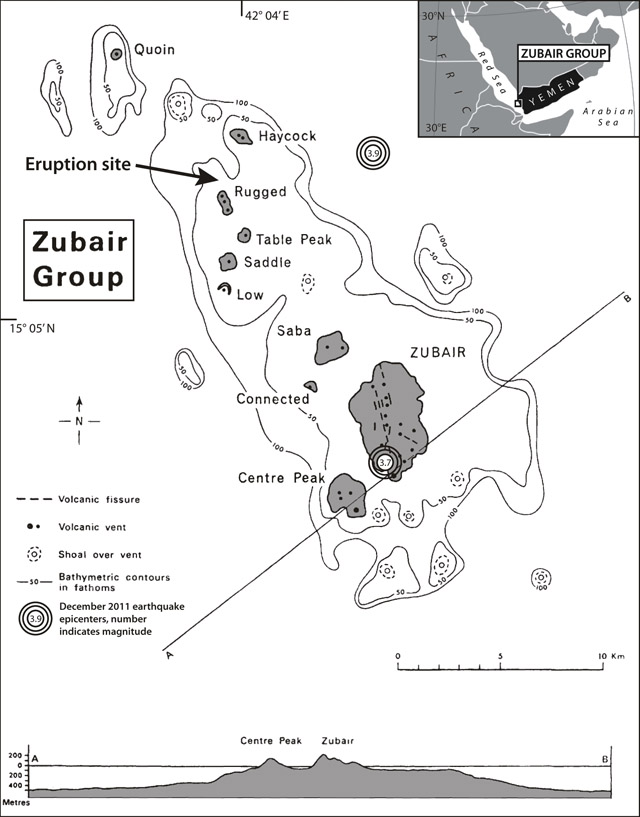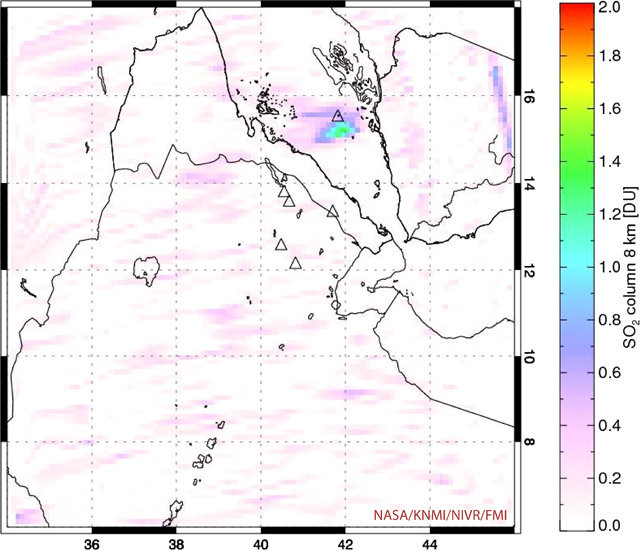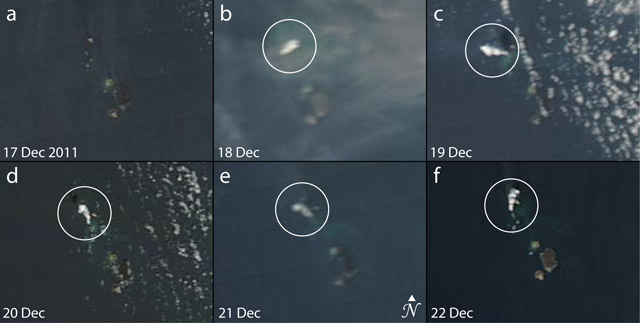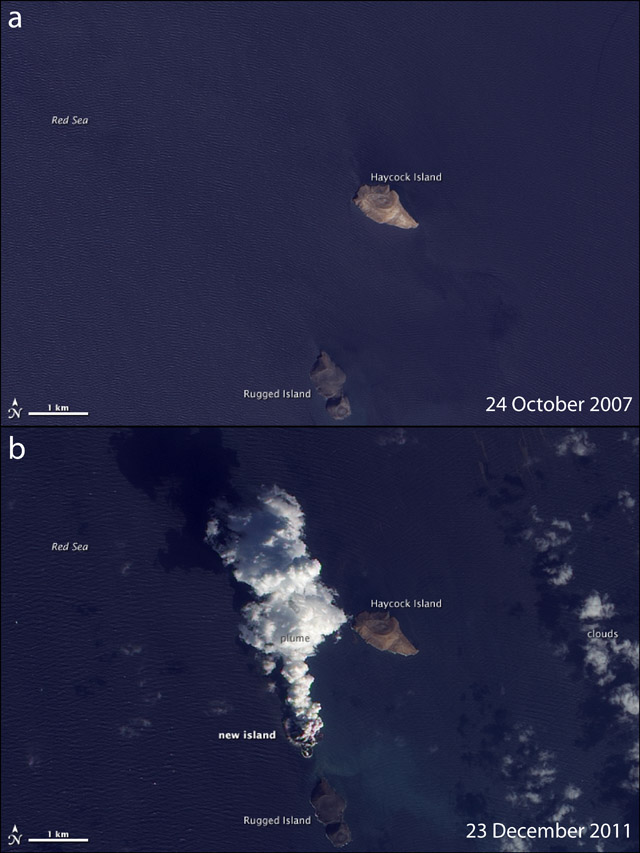Recently Published Bulletin Reports
Erebus (Antarctica) Lava lake remains active; most thermal alerts recorded since 2019
Rincon de la Vieja (Costa Rica) Frequent phreatic explosions during July-December 2023
Bezymianny (Russia) Explosion on 18 October 2023 sends ash plume 8 km high; lava flows and incandescent avalanches
Kilauea (United States) Low-level lava effusions in the lava lake at Halema’uma’u during July-December 2022
Nyamulagira (DR Congo) Lava flows and thermal activity during May-October 2023
Bagana (Papua New Guinea) Explosions, ash plumes, ashfall, and lava flows during April-September 2023
Mayon (Philippines) Lava flows, pyroclastic flows, ash emissions, and seismicity during April-September 2023
Nishinoshima (Japan) Eruption plumes and gas-and-steam plumes during May-August 2023
Krakatau (Indonesia) White gas-and-steam plumes and occasional ash plumes during May-August 2023
Villarrica (Chile) Strombolian activity, gas-and-ash emissions, and crater incandescence during April-September 2023
Merapi (Indonesia) Frequent incandescent avalanches during April-September 2023
Ebeko (Russia) Moderate explosive activity with ash plumes continued during June-November 2023
Erebus (Antarctica) — January 2024  Cite this Report
Cite this Report
Erebus
Antarctica
77.53°S, 167.17°E; summit elev. 3794 m
All times are local (unless otherwise noted)
Lava lake remains active; most thermal alerts recorded since 2019
The lava lake in the summit crater of Erebus has been active since at least 1972. Located in Antarctica overlooking the McMurdo Station on Ross Island, it is the southernmost active volcano on the planet. Because of the remote location, activity is primarily monitored by satellites. This report covers activity during 2023.
The number of thermal alerts recorded by the Hawai'i Institute of Geophysics and Planetology’s MODVOLC Thermal Alerts System increased considerably in 2023 compared to the years 2020-2022 (table 9). In contrast to previous years, the MODIS instruments aboard the Aqua and Terra satellites captured data from Erebus every month during 2023. Consistent with previous years, the lowest number of anomalous pixels were recorded in January, November, and December.
Table 9. Number of monthly MODIS-MODVOLC thermal alert pixels recorded at Erebus during 2017-2023. See BGVN 42:06 for data from 2000 through 2016. The table was compiled using data provided by the HIGP – MODVOLC Thermal Alerts System.
| Year |
Jan |
Feb |
Mar |
Apr |
May |
Jun |
Jul |
Aug |
Sep |
Oct |
Nov |
Dec |
SUM |
| 2017 |
0 |
21 |
9 |
0 |
0 |
1 |
11 |
61 |
76 |
52 |
0 |
3 |
234 |
| 2018 |
0 |
21 |
58 |
182 |
55 |
17 |
137 |
172 |
103 |
29 |
0 |
0 |
774 |
| 2019 |
2 |
21 |
162 |
151 |
55 |
56 |
75 |
53 |
29 |
19 |
1 |
0 |
624 |
| 2020 |
0 |
2 |
16 |
18 |
4 |
4 |
1 |
3 |
18 |
3 |
1 |
6 |
76 |
| 2021 |
0 |
9 |
1 |
0 |
2 |
56 |
46 |
47 |
35 |
52 |
5 |
3 |
256 |
| 2022 |
1 |
13 |
55 |
22 |
15 |
32 |
39 |
19 |
31 |
11 |
0 |
0 |
238 |
| 2023 |
2 |
33 |
49 |
82 |
41 |
32 |
70 |
64 |
42 |
17 |
5 |
11 |
448 |
Sentinel-2 infrared images showed one or two prominent heat sources within the summit crater, accompanied by adjacent smaller sources, similar to recent years (see BGVN 46:01, 47:02, and 48:01). A unique image was obtained on 25 November 2023 by the OLI-2 (Operational Land Imager-2) on Landsat 9, showing the upper part of the volcano surrounded by clouds (figure 32).
Geologic Background. Mount Erebus, the world's southernmost historically active volcano, overlooks the McMurdo research station on Ross Island. It is the largest of three major volcanoes forming the crudely triangular Ross Island. The summit of the dominantly phonolitic volcano has been modified by one or two generations of caldera formation. A summit plateau at about 3,200 m elevation marks the rim of the youngest caldera, which formed during the late-Pleistocene and within which the modern cone was constructed. An elliptical 500 x 600 m wide, 110-m-deep crater truncates the summit and contains an active lava lake within a 250-m-wide, 100-m-deep inner crater; other lava lakes are sometimes present. The glacier-covered volcano was erupting when first sighted by Captain James Ross in 1841. Continuous lava-lake activity with minor explosions, punctuated by occasional larger Strombolian explosions that eject bombs onto the crater rim, has been documented since 1972, but has probably been occurring for much of the volcano's recent history.
Information Contacts: Hawai'i Institute of Geophysics and Planetology (HIGP) - MODVOLC Thermal Alerts System, School of Ocean and Earth Science and Technology (SOEST), Univ. of Hawai'i, 2525 Correa Road, Honolulu, HI 96822, USA (URL: http://modis.higp.hawaii.edu/); Copernicus Browser, Copernicus Data Space Ecosystem, European Space Agency (URL: https://dataspace.copernicus.eu/browser/); NASA Earth Observatory, EOS Project Science Office, NASA Goddard Space Flight Center, Goddard, Maryland, USA (URL: https://earthobservatory.nasa.gov/images/152134/erebus-breaks-through).
Rincon de la Vieja (Costa Rica) — January 2024  Cite this Report
Cite this Report
Rincon de la Vieja
Costa Rica
10.83°N, 85.324°W; summit elev. 1916 m
All times are local (unless otherwise noted)
Frequent phreatic explosions during July-December 2023
Rincón de la Vieja is a volcanic complex in Costa Rica with a hot convecting acid lake that exhibits frequent weak phreatic explosions, gas-and-steam emissions, and occasional elevated sulfur dioxide levels (BGVN 45:10, 46:03, 46:11). The current eruption period began June 2021. This report covers activity during July-December 2023 and is based on weekly bulletins and occasional daily reports from the Observatorio Vulcanologico Sismologica de Costa Rica-Universidad Nacional (OVSICORI-UNA).
Numerous weak phreatic explosions continued during July-December 2023, along with gas-and-steam emissions and plumes that rose as high as 3 km above the crater rim. Many weekly OVSICORI-UNA bulletins included the previous week's number of explosions and emissions (table 9). For many explosions, the time of explosion was given (table 10). Frequent seismic activity (long-period earthquakes, volcano-tectonic earthquakes, and tremor) accompanied the phreatic activity.
Table 9. Number of reported weekly phreatic explosions and gas-and-steam emissions at Rincón de la Vieja, July-December 2023. Counts are reported for the week before the Weekly Bulletin date; not all reports included these data. Courtesy of OVSICORI-UNA.
| OVSICORI Weekly Bulletin |
Number of explosions |
Number of emissions |
| 28 Jul 2023 |
6 |
14 |
| 4 Aug 2023 |
10 |
12 |
| 1 Sep 2023 |
13 |
11 |
| 22 Sep 2023 |
12 |
13 |
| 29 Sep 2023 |
6 |
11 |
| 6 Oct 2023 |
12 |
5 |
| 13 Oct 2023 |
7 |
9 |
| 20 Oct 2023 |
1 |
15 |
| 27 Oct 2023 |
3 |
23 |
| 3 Nov 2023 |
3 |
10 |
| 17 Nov 2023 |
0 |
Some |
| 24 Nov 2023 |
0 |
14 |
| 8 Dec 2023 |
4 |
16 |
| 22 Dec 2023 |
8 |
18 |
Table 10. Summary of activity at Rincón de la Vieja during July-December 2023. Weak phreatic explosions and gas emissions are noted where the time of explosion was indicated in the weekly or daily bulletins. Height of plumes or emissions are distance above the crater rim. Courtesy of OVSICORI-UNA.
| Date |
Time |
Description of Activity |
| 1 Jul 2023 |
0156 |
Explosion. |
| 2 Jul 2023 |
0305 |
Explosion. |
| 4 Jul 2023 |
0229, 0635 |
Event at 0635 produced a gas-and-steam plume that rose 700 m and drifted W; seen by residents in Liberia (21 km SW). |
| 9 Jul 2023 |
1843 |
Explosion. |
| 21 Jul 2023 |
0705 |
Explosion. |
| 26 Jul 2023 |
1807 |
Explosion. |
| 28 Jul 2023 |
0802 |
Explosion generated a gas-and-steam plume that rose 500 m. |
| 30 Jul 2023 |
1250 |
Explosion. |
| 31 Jul 2023 |
2136 |
Explosion. |
| 11 Aug 2023 |
0828 |
Explosion. |
| 18 Aug 2023 |
1304 |
Explosion. |
| 21 Aug 2023 |
1224 |
Explosion generated gas-and-steam plumes rose 500-600 m. |
| 22 Aug 2023 |
0749 |
Explosion generated gas-and-steam plumes rose 500-600 m. |
| 24 Aug 2023 |
1900 |
Explosion. |
| 25 Aug 2023 |
0828 |
Event produced a steam-and-gas plume that rose 3 km and drifted NW. |
| 27-28 Aug 2023 |
0813 |
Four small events; the event at 0813 on 28 August lasted two minutes and generated a steam-and-gas plume that rose 2.5 km. |
| 1 Sep 2023 |
1526 |
Explosion generated plume that rose 2 km and ejected material onto the flanks. |
| 2-3 Sep 2023 |
- |
Small explosions detected in infrasound data. |
| 4 Sep 2023 |
1251 |
Gas-and-steam plume rose 1 km and drifted W. |
| 7 Nov 2023 |
1113 |
Explosion. |
| 8 Nov 2023 |
0722 |
Explosion. |
| 12 Nov 2023 |
0136 |
Small gas emissions. |
| 14 Nov 2023 |
0415 |
Small gas emissions. |
According to OVSICORI-UNA, during July-October the average weekly sulfur dioxide (SO2) flux ranged from 68 to 240 tonnes/day. However, in mid-November the flux increased to as high as 334 tonnes/day, the highest value measured in recent years. The high SO2 flux in mid-November was also detected by the TROPOMI instrument on the Sentinel-5P satellite (figure 43).
Geologic Background. Rincón de la Vieja, the largest volcano in NW Costa Rica, is a remote volcanic complex in the Guanacaste Range. The volcano consists of an elongated, arcuate NW-SE-trending ridge constructed within the 15-km-wide early Pleistocene Guachipelín caldera, whose rim is exposed on the south side. Sometimes known as the "Colossus of Guanacaste," it has an estimated volume of 130 km3 and contains at least nine major eruptive centers. Activity has migrated to the SE, where the youngest-looking craters are located. The twin cone of Santa María volcano, the highest peak of the complex, is located at the eastern end of a smaller, 5-km-wide caldera and has a 500-m-wide crater. A Plinian eruption producing the 0.25 km3 Río Blanca tephra about 3,500 years ago was the last major magmatic eruption. All subsequent eruptions, including numerous historical eruptions possibly dating back to the 16th century, have been from the prominent active crater containing a 500-m-wide acid lake located ENE of Von Seebach crater.
Information Contacts: Observatorio Vulcanológico Sismológica de Costa Rica-Universidad Nacional (OVSICORI-UNA), Apartado 86-3000, Heredia, Costa Rica (URL: http://www.ovsicori.una.ac.cr/); NASA Global Sulfur Dioxide Monitoring Page, Atmospheric Chemistry and Dynamics Laboratory, NASA Goddard Space Flight Center (NASA/GSFC), 8800 Greenbelt Road, Goddard MD 20771, USA (URL: https://so2.gsfc.nasa.gov/).
Bezymianny (Russia) — November 2023  Cite this Report
Cite this Report
Bezymianny
Russia
55.972°N, 160.595°E; summit elev. 2882 m
All times are local (unless otherwise noted)
Explosion on 18 October 2023 sends ash plume 8 km high; lava flows and incandescent avalanches
Bezymianny, located on Russia’s Kamchatka Peninsula, has had eruptions since 1955 characterized by dome growth, explosions, pyroclastic flows, ash plumes, and ashfall. Activity during November 2022-April 2023 included gas-and-steam emissions, lava dome collapses generating avalanches, and persistent thermal activity. Similar eruptive activity continued from May through October 2023, described here based on information from weekly and daily reports of the Kamchatka Volcano Eruptions Response Team (KVERT), notices from Tokyo VAAC (Volcanic Ash Advisory Center), and from satellite data.
Overall activity decreased after the strong period of activity in late March through April 2023, which included ash explosions during 29 March and 7-8 April 2023 that sent plumes as high as 10-12 km altitude, along with dome growth and lava flows (BGVN 48:05). This reduced activity can be seen in the MIROVA thermal detection system graph (figure 56), which was consistent with data from the MODVOLC thermal detection system and with Sentinel-2 satellite images that showed persistent hotspots in the summit crater when conditions allowed observations. A renewed period of strong activity began in mid-October 2023.
Activity increased significantly on 17 October 2023 when large collapses began during 0700-0830 on the E flanks of the lava dome and continued to after 0930 the next day (figure 57). Ash plumes rose to an altitude of 4.5-5 km, extending 220 km NNE by 18 October. A large explosion at 1630 on 18 October produced an ash plume that rose to an altitude of 11 km (8 km above the summit) and drifted NNE and then NW, extending 900 km NW within two days at an altitude of 8 km. Minor ashfall was noted in Kozyrevsk (45 km WNW). At 0820 on 20 October an ash plume was identified in satellite images drifting 100 km ENE at altitudes of 4-4.5 km.
Lava flows and hot avalanches from the dome down the SE flank continued over the next few days, including 23 October when clear conditions allowed good observations (figures 58 and 59). A large thermal anomaly was observed over the volcano through 24 October, and in the summit crater on 30 October (figure 60). Strong fumarolic activity continued, with numerous avalanches and occasional incandescence. By the last week of October, volcanic activity had decreased to a level consistent with that earlier in the reporting period.
Aviation warnings were frequently updated during 17-20 October. KVERT issued a Volcano Observatory Notice for Aviation (VONA) on 17 October at 1419 and 1727 (0219 and 0527 UTC) raising the Aviation Color Code (ACC) from Yellow to Orange (second highest level). The next day, KVERT issued a VONA at 1705 (0505 UTC) raising the ACC to Red (highest level) but lowered it back to Orange at 2117 (0917 UTC). After another decrease to Yellow and back to Orange, the ACC was reduced to Yellow on 20 October at 1204 (0004 UTC). In addition, the Tokyo VAAC issued a series of Volcanic Ash Advisories beginning on 16 October and continuing through 30 October.
Geologic Background. The modern Bezymianny, much smaller than its massive neighbors Kamen and Kliuchevskoi on the Kamchatka Peninsula, was formed about 4,700 years ago over a late-Pleistocene lava-dome complex and an edifice built about 11,000-7,000 years ago. Three periods of intensified activity have occurred during the past 3,000 years. The latest period, which was preceded by a 1,000-year quiescence, began with the dramatic 1955-56 eruption. This eruption, similar to that of St. Helens in 1980, produced a large open crater that was formed by collapse of the summit and an associated lateral blast. Subsequent episodic but ongoing lava-dome growth, accompanied by intermittent explosive activity and pyroclastic flows, has largely filled the 1956 crater.
Information Contacts: Kamchatka Volcanic Eruptions Response Team (KVERT), Far Eastern Branch, Russian Academy of Sciences, 9 Piip Blvd., Petropavlovsk-Kamchatsky, 683006, Russia (URL: http://www.kscnet.ru/ivs/kvert/); Kamchatka Volcanological Station, Kamchatka Branch of Geophysical Survey, (KB GS RAS), Klyuchi, Kamchatka Krai, Russia (URL: http://volkstat.ru/); Tokyo Volcanic Ash Advisory Center (VAAC), 1-3-4 Otemachi, Chiyoda-ku, Tokyo 100-8122, Japan (URL: http://ds.data.jma.go.jp/svd/vaac/data/); Hawai'i Institute of Geophysics and Planetology (HIGP) - MODVOLC Thermal Alerts System, School of Ocean and Earth Science and Technology (SOEST), Univ. of Hawai'i, 2525 Correa Road, Honolulu, HI 96822, USA (URL: http://modis.higp.hawaii.edu/); MIROVA (Middle InfraRed Observation of Volcanic Activity), a collaborative project between the Universities of Turin and Florence (Italy) supported by the Centre for Volcanic Risk of the Italian Civil Protection Department (URL: http://www.mirovaweb.it/); Copernicus Browser, Copernicus Data Space Ecosystem, European Space Agency (URL: https://dataspace.copernicus.eu/browser/).chr
Kilauea (United States) — January 2023  Cite this Report
Cite this Report
Kilauea
United States
19.421°N, 155.287°W; summit elev. 1222 m
All times are local (unless otherwise noted)
Low-level lava effusions in the lava lake at Halema’uma’u during July-December 2022
Kīlauea is the southeastern-most volcano in Hawaii and overlaps the E flank of the Mauna Loa volcano. Its East Rift Zone (ERZ) has been intermittently active for at least 2,000 years. An extended eruption period began in January 1983 and was characterized by open lava lakes and lava flows from the summit caldera and the East Rift Zone. During May 2018 magma migrated into the Lower East Rift Zone (LERZ) and opened 24 fissures along a 6-km-long NE-trending fracture zone that produced lava flows traveling in multiple directions. As lava emerged from the fissures, the lava lake at Halema'uma'u drained and explosions sent ash plumes to several kilometers altitude (BGVN 43:10).
The current eruption period started during September 2021 and has recently been characterized by lava effusions, spatter, and sulfur dioxide emissions in the active Halema’uma’u lava lake (BGVN 47:08). Lava effusions, some spatter, and sulfur dioxide emissions have continued during this reporting period of July through December 2022 using daily reports, volcanic activity notices, and abundant photo, map, and video data from the US Geological Survey's (USGS) Hawaiian Volcano Observatory (HVO).
Summary of activity during July-December 2022. Low-level effusions have continued at the western vent of the Halema’uma’u crater during July through early December 2022. Occasional weak ooze-outs (also called lava break outs) would occur along the margins of the crater floor. The overall level of the active lava lake throughout the reporting period gradually increased due to infilling, however it stagnated in mid-September (table 13). During September through November, activity began to decline, though lava effusions persisted at the western vent. By 9 December, the active part of the lava lake had completely crusted over, and incandescence was no longer visible.
Table 13. Summary of measurements taken during overflights at Kīlauea that show a gradual increase in the active lava lake level and the volume of lava effused since 29 September 2021. Lower activity was reported during September-October. Data collected during July-December 2022. Courtesy of HVO.
| Date: |
Level of the active lava lake (m): |
Cumulative volume of lava effused (million cubic meters): |
| 7 Jul 2022 |
130 |
95 |
| 19 Jul 2022 |
133 |
98 |
| 4 Aug 2022 |
136 |
102 |
| 16 Aug 2022 |
137 |
104 |
| 12 Sep 2022 |
143 |
111 |
| 5 Oct 2022 |
143 |
111 |
| 28 Oct 2022 |
143 |
111 |
Activity during July 2022. Lava effusions were reported from the western vent in the Halema’uma’u crater, along with occasional weak ooze-outs along the margins of the crater floor. The height of the lava lake was variable due to deflation-inflation tilt events; for example, the lake level dropped approximately 3-4 m during a summit deflation-inflation event reported on 1 July. Webcam images taken during the night of 6-12 July showed intermittent low-level spattering at the western vent that rose less than 10 m above the vent (figure 519). Measurements made during an overflight on 7 July indicated that the crater floor was infilled about 130 m and that 95 million cubic meters of lava had been effused since 29 September 2021. A single, relatively small lava ooze-out was active to the S of the lava lake. Around midnight on 8 July there were two brief periods of lava overflow onto the lake margins. On 9 July lava ooze-outs were reported near the SE and NE edges of the crater floor and during 10-11 July they occurred near the E, NE, and NW edges. On 16 July crater incandescence was reported, though the ooze-outs and spattering were not visible. On 18 July overnight webcam images showed incandescence in the western vent complex and two ooze-outs were reported around 0000 and 0200 on 19 July. By 0900 there were active ooze-outs along the SW edge of the crater floor. Measurements made from an overflight on 19 July indicated that the crater floor was infilled about 133 m and 98 million cubic meters of lava had erupted since 29 September 2021 (figure 520). On 20 July around 1600 active ooze-outs were visible along the N edge of the crater, which continued through the next day. Extensive ooze-outs occurred along the W margin during 24 July until 1900; on 26 July minor ooze-outs were noted along the N margin. Minor spattering was visible on 29 July along the E margin of the lake. The sulfur dioxide emission rates ranged 650-2,800 tons per day (t/d), the higher of which was measured on 8 July (figure 519).
Activity during August 2022. The eruption continued in the Halema’uma’u crater at the western vent. According to HVO the lava in the active lake remained at the level of the bounding levees. Occasional minor ooze-outs were observed along the margins of the crater floor. Strong nighttime crater incandescence was visible after midnight on 6 August over the western vent cone. During 6-7 August scattered small lava lobes were active along the crater floor and incandescence persisted above the western vent through 9 August. During 7-9 August HVO reported a single lava effusion source was active along the NW margin of the crater floor. Measurements from an overflight on 4 August indicated that the crater floor was infilled about 136 m total and that 102 million cubic meters of lava had been erupted since the start of the eruption. Lava breakouts were reported along the N, NE, E, S, and W margins of the crater during 10-16 August. Another overflight survey conducted on 16 August indicated that the crater floor infilled about 137 m and 104 million cubic meters of lava had been erupted since September 2021. Measured sulfur dioxide emissions rates ranged 1,150-2,450 t/d, the higher of which occurred on 8 August.
Activity during September 2022. During September, lava effusion continued from the western vent into the active lava lake and onto the crater floor. Intermittent minor ooze-outs were reported through the month. A small ooze-out was visible on the W crater floor margin at 0220 on 2 September, which showed decreasing surface activity throughout the day, but remained active through 3 September. On 3 September around 1900 a lava outbreak occurred along the NW margin of the crater floor but had stopped by the evening of 4 September. Field crews monitoring the summit lava lake on 9 September observed spattering on the NE margin of the lake that rose no higher than 10 m, before falling back onto the lava lake crust (figure 521). Overflight measurements on 12 September indicated that the crater floor was infilled a total of 143 m and 111 million cubic meters of lava had been erupted since September 2021. Extensive breakouts in the W and N part of the crater floor were reported at 1600 on 20 September and continued into 26 September. The active part of the lava lake dropped by 10 m while other parts of the crater floor dropped by several meters. Summit tiltmeters recorded a summit seismic swarm of more than 80 earthquakes during 1500-1800 on 21 September, which occurred about 1.5 km below Halema’uma’u; a majority of these were less than Mw 2. By 22 September the active part of the lava lake was infilled about 2 m. On 23 September the western vent areas exhibited several small spatter cones with incandescent openings, along with weak, sporadic spattering (figure 522). The sulfur dioxide emission rate ranged from 930 t/d to 2,000 t/d, the higher of which was measured on 6 September.
Activity during October 2022. Activity during October declined slightly compared to previous months, though lava effusions persisted from the western vent into the active lava lake and onto the crater floor during October (figure 523). Slight variations in the lava lake were noted throughout the month. HVO reported that around 0600 on 3 October the level of the lava lake has lowered slightly. Overflight measurements taken on 5 October indicated that the crater floor was infilled a total of about 143 m and that 111 million cubic meters of lava had been effused since September 2021. During 6-7 October the lake gradually rose 0.5 m. Sulfur dioxide measurements made on 22 October had an emission rate of 700 t/d. Another overflight taken on 28 October showed that there was little to no change in the elevation of the crater floor: the crater floor was infilled a total of 143 m and 111 million cubic meters of lava had erupted since the start of the eruption.
Activity during November 2022. Activity remained low during November, though HVO reported that lava from the western vent continued to effuse into the active lava lake and onto the crater floor throughout the month. The rate of sulfur dioxide emissions during November ranged from 300-600 t/d, the higher amount of which occurred on 9 November.
Activity during December 2022. Similar low activity was reported during December, with lava effusing from the western vent into the active lava lake and onto the crater floor. During 4-5 December the active part of the lava lake was slightly variable in elevation and fluctuated within 1 m. On 9 December HVO reported that lava was no longer erupting from the western vent in the Halema’uma’u crater and that sulfur dioxide emissions had returned to near pre-eruption background levels; during 10-11 December, the lava lake had completely crusted over, and no incandescence was visible (figure 524). Time lapse camera images covering the 4-10 December showed that the crater floor showed weak deflation and no inflation. Some passive events of crustal overturning were reported during 14-15 December, which brought fresh incandescent lava to the lake surface. The sulfur dioxide emission rate was approximately 200 t/d on 14 December. A smaller overturn event on 17 December and another that occurred around 0000 and into the morning of 20 December were also detected. A small seismic swarm was later detected on 30 December.
Geologic Background. Kilauea overlaps the E flank of the massive Mauna Loa shield volcano in the island of Hawaii. Eruptions are prominent in Polynesian legends; written documentation since 1820 records frequent summit and flank lava flow eruptions interspersed with periods of long-term lava lake activity at Halemaumau crater in the summit caldera until 1924. The 3 x 5 km caldera was formed in several stages about 1,500 years ago and during the 18th century; eruptions have also originated from the lengthy East and Southwest rift zones, which extend to the ocean in both directions. About 90% of the surface of the basaltic shield volcano is formed of lava flows less than about 1,100 years old; 70% of the surface is younger than 600 years. The long-term eruption from the East rift zone between 1983 and 2018 produced lava flows covering more than 100 km2, destroyed hundreds of houses, and added new coastline.
Information Contacts: Hawaiian Volcano Observatory (HVO), U.S. Geological Survey, PO Box 51, Hawai'i National Park, HI 96718, USA (URL: http://hvo.wr.usgs.gov/).
Nyamulagira (DR Congo) — November 2023  Cite this Report
Cite this Report
Nyamulagira
DR Congo
1.408°S, 29.2°E; summit elev. 3058 m
All times are local (unless otherwise noted)
Lava flows and thermal activity during May-October 2023
Nyamulagira (also known as Nyamuragira) is a shield volcano in the Democratic Republic of Congo with the summit truncated by a small 2 x 2.3 km caldera with walls up to about 100 m high. Documented eruptions have occurred within the summit caldera, as well as from numerous flank fissures and cinder cones. The current eruption period began in April 2018 and has more recently been characterized by summit crater lava flows and thermal activity (BGVN 48:05). This report describes lava flows and variable thermal activity during May through October 2023, based on information from the Observatoire Volcanologique de Goma (OVG) and various satellite data.
Lava lake activity continued during May. The MIROVA (Middle InfraRed Observation of Volcanic Activity) system recorded moderate-to-strong thermal activity throughout the reporting period; activity was more intense during May and October and relatively weaker from June through September (figure 95). The MODVOLC thermal algorithm, detected a total of 209 thermal alerts. There were 143 hotspots detected during May, eight during June, nine during September, and 49 during October. This activity was also reflected in infrared satellite images, where a lava flow was visible in the NW part of the crater on 7 May and strong activity was seen in the center of the crater on 4 October (figure 96). Another infrared satellite image taken on 12 May showed still active lava flows along the NW margin of the crater. According to OVG lava effusions were active during 7-29 May and moved to the N and NW parts of the crater beginning on 9 May. Strong summit crater incandescence was visible from Goma (27 km S) during the nights of 17, 19, and 20 May (figure 97). On 17 May there was an increase in eruptive activity, which peaked at 0100 on 20 May. Notable sulfur dioxide plumes drifted NW and W during 19-20 May (figure 98). Drone footage acquired in partnership with the USGS (United States Geological Survey) on 20 May captured images of narrow lava flows that traveled about 100 m down the W flank (figure 99). Data from the Rumangabo seismic station indicated a decreasing trend in activity during 17-21 May. Although weather clouds prevented clear views of the summit, a strong thermal signature on the NW flank was visible in an infrared satellite image on 22 May, based on an infrared satellite image. On 28 May the lava flows on the upper W flank began to cool and solidify. By 29 May seismicity returned to levels similar to those recorded before the 17 May increase. Lava effusion continued but was confined to the summit crater; periodic crater incandescence was observed.
Low-level activity was noted during June through October. On 1 June OVG reported that seismicity remained at lower levels and that crater incandescence had been absent for three days, though infrared satellite imagery showed continued lava effusion in the summit crater. The lava flows on the flanks covered an estimated 0.6 km2. Satellite imagery continued to show thermal activity confined to the lava lake through October (figure 96), although no lava flows or significant sulfur dioxide emissions were reported.
Geologic Background. Africa's most active volcano, Nyamulagira (also known as Nyamuragira), is a massive high-potassium basaltic shield about 25 km N of Lake Kivu and 13 km NNW of the steep-sided Nyiragongo volcano. The summit is truncated by a small 2 x 2.3 km caldera that has walls up to about 100 m high. Documented eruptions have occurred within the summit caldera, as well as from the numerous flank fissures and cinder cones. A lava lake in the summit crater, active since at least 1921, drained in 1938, at the time of a major flank eruption. Recent lava flows extend down the flanks more than 30 km from the summit as far as Lake Kivu; extensive lava flows from this volcano have covered 1,500 km2 of the western branch of the East African Rift.
Information Contacts: Observatoire Volcanologique de Goma (OVG), Departement de Geophysique, Centre de Recherche en Sciences Naturelles, Lwiro, D.S. Bukavu, DR Congo; Hawai'i Institute of Geophysics and Planetology (HIGP) - MODVOLC Thermal Alerts System, School of Ocean and Earth Science and Technology (SOEST), Univ. of Hawai'i, 2525 Correa Road, Honolulu, HI 96822, USA (URL: http://modis.higp.hawaii.edu/); MIROVA (Middle InfraRed Observation of Volcanic Activity), a collaborative project between the Universities of Turin and Florence (Italy) supported by the Centre for Volcanic Risk of the Italian Civil Protection Department (URL: http://www.mirovaweb.it/); NASA Global Sulfur Dioxide Monitoring Page, Atmospheric Chemistry and Dynamics Laboratory, NASA Goddard Space Flight Center (NASA/GSFC), 8800 Greenbelt Road, Goddard, Maryland, USA (URL: https://so2.gsfc.nasa.gov/); Copernicus Browser, Copernicus Data Space Ecosystem, European Space Agency (URL: https://dataspace.copernicus.eu/browser/); Charles Balagizi, Goma Volcano Observatory, Departement de Geophysique, Centre de Recherche en Sciences Naturelles, Lwiro, D.S. Bukavu, DR Congo.
Bagana (Papua New Guinea) — October 2023  Cite this Report
Cite this Report
Bagana
Papua New Guinea
6.137°S, 155.196°E; summit elev. 1855 m
All times are local (unless otherwise noted)
Explosions, ash plumes, ashfall, and lava flows during April-September 2023
The remote volcano of Bagana is located in central Bougainville Island, Papua New Guinea. Recorded eruptions date back to 1842 and activity has consisted of effusive activity that has built a small lava dome in the summit crater and occasional explosions that produced pyroclastic flows. The most recent eruption has been ongoing since February 2000 and has produced occasional explosions, ash plumes, and lava flows. More recently, activity has been characterized by ongoing effusive activity and ash emissions (BGVN 48:04). This report updates activity from April through September 2023 that has consisted of explosions, ash plumes, ashfall, and lava flows, using information from the Darwin Volcanic Ash Advisory Center (VAAC) and satellite data.
An explosive eruption was reported on 7 July that generated a large gas-and-ash plume to high altitudes and caused significant ashfall in local communities; the eruption plume had reached upper tropospheric (16-18 km altitude) altitudes by 2200, according to satellite images. Sulfur dioxide plumes were detected in satellite images on 8 July and indicated that the plume was likely a mixture of gas, ice, and ash. A report issued by the Autonomous Bougainville Government (ABG) (Torokina District, Education Section) on 10 July noted that significant ash began falling during 2000-2100 on 7 July and covered most areas in the Vuakovi, Gotana (9 km SW), Koromaketo, Laruma (25 km W) and Atsilima (27 km NW) villages. Pyroclastic flows also occurred, according to ground-based reports; small deposits confined to one drainage were inspected by RVO during an overflight on 17 July and were confirmed to be from the 7 July event. Ashfall continued until 10 July and covered vegetation, which destroyed bushes and gardens and contaminated rivers and streams.
RVO reported another eruption on 14 July. The Darwin VAAC stated that an explosive event started around 0830 on 15 July and produced an ash plume that rose to 16.5 km altitude by 1000 and drifted N, according to satellite images. The plume continued to drift N and remained visible through 1900, and by 2150 it had dissipated.
Ashfall likely from both the 7 and 15 July events impacted about 8,111 people in Torokina (20 km SW), including Tsito/Vuakovi, Gotana, Koromaketo, Kenaia, Longkogari, Kenbaki, Piva (13 km SW), and Atsinima, and in the Tsitovi district, according to ABG. Significant ashfall was also reported in Ruruvu (22 km N) in the Wakunai District of Central Bougainville, though the thickness of these deposits could not be confirmed. An evacuation was called for the villages in Wakunai, where heavy ashfall had contaminated water sources; the communities of Ruruvu, Togarau, Kakarapaia, Karauturi, Atao, and Kuritaturi were asked to evacuate to a disaster center at the Wakunai District Station, and communities in Torokina were asked to evacuate to the Piva District station. According to a news article, more than 7,000 people needed temporary accommodations, with about 1,000 people in evacuation shelters. Ashfall had deposited over a broad area, contaminating water supplies, affecting crops, and collapsing some roofs and houses in rural areas. Schools were temporarily shut down. Intermittent ash emissions continued through the end of July and drifted NNW, NW, and SW. Fine ashfall was reported on the coast of Torokina, and ash plumes also drifted toward Laruma and Atsilima.
A small explosive eruption occurred at 2130 on 28 July that ejected material from the crater vents, according to reports from Torokina, in addition to a lava flow that contained two lobes. A second explosion was detected at 2157. Incandescence from the lava flow was visible from Piva as it descended the W flank around 2000 on 29 July (figure 47). The Darwin VAAC reported that a strong thermal anomaly was visible in satellite images during 30-31 July and that ash emissions rose to 2.4 km altitude and drifted WSW on 30 July. A ground report from RVO described localized emissions at 0900 on 31 July.
The Darwin VAAC reported that ash plumes were identified in satellite imagery at 0800 and 1220 on 12 August and rose to 2.1 km and 3 km altitude and drifted NW and W, respectively. A news report stated that aid was sent to more than 6,300 people that were adversely affected by the eruption. Photos taken during 17-19 August showed ash emissions rising no higher than 1 km above the summit and drifting SE. A small explosion generated an ash plume during the morning of 19 August. Deposits from small pyroclastic flows were also captured in the photos. Satellite images captured lava flows and pyroclastic flow deposits. Two temporary seismic stations were installed near Bagana on 17 August at distances of 7 km WSW (Vakovi station) and 11 km SW (Kepox station). The Kepox station immediately started to record continuous, low-frequency background seismicity.
Satellite data. Little to no thermal activity was detected during April through mid-July 2023; only one anomaly was recorded during early April and one during early June, according to MIROVA (Middle InfraRed Observation of Volcanic Activity) data (figure 48). Thermal activity increased in both power and frequency during mid-July through September, although there were still some short gaps in detected activity. MODVOLC also detected increased thermal activity during August; thermal hotspots were detected a total of five times on 19, 20, and 27 August. Weak thermal anomalies were also captured in infrared satellite images on clear weather days throughout the reporting period on 7, 12, and 17 April, 27 May, 1, 6, 16, and 31 July, and 19 September (figure 48); a strong thermal anomaly was visible on 31 July. Distinct sulfur dioxide plumes that drifted generally NW were intermittently captured by the TROPOMI instrument on the Sentinel-5P satellite and sometimes exceeded two Dobson Units (DUs) (figure 49).
Geologic Background. Bagana volcano, in a remote portion of central Bougainville Island, is frequently active. This massive symmetrical cone was largely constructed by an accumulation of viscous andesitic lava flows. The entire edifice could have been constructed in about 300 years at its present rate of lava production. Eruptive activity is characterized by non-explosive effusion of viscous lava that maintains a small lava dome in the summit crater, although occasional explosive activity produces pyroclastic flows. Lava flows with tongue-shaped lobes up to 50 m thick and prominent levees descend the flanks on all sides.
Information Contacts: Rabaul Volcano Observatory (RVO), Geohazards Management Division, Department of Mineral Policy and Geohazards Management (DMPGM), PO Box 3386, Kokopo, East New Britain Province, Papua New Guinea; Darwin Volcanic Ash Advisory Centre (VAAC), Bureau of Meteorology, Northern Territory Regional Office, PO Box 40050, Casuarina, NT 0811, Australia (URL: http://www.bom.gov.au/info/vaac/); MIROVA (Middle InfraRed Observation of Volcanic Activity), a collaborative project between the Universities of Turin and Florence (Italy) supported by the Centre for Volcanic Risk of the Italian Civil Protection Department (URL: http://www.mirovaweb.it/); Hawai'i Institute of Geophysics and Planetology (HIGP) - MODVOLC Thermal Alerts System, School of Ocean and Earth Science and Technology (SOEST), Univ. of Hawai'i, 2525 Correa Road, Honolulu, HI 96822, USA (URL: http://modis.higp.hawaii.edu/); NASA Global Sulfur Dioxide Monitoring Page, Atmospheric Chemistry and Dynamics Laboratory, NASA Goddard Space Flight Center (NASA/GSFC), 8800 Greenbelt Road, Goddard, Maryland, USA (URL: https://so2.gsfc.nasa.gov/); Copernicus Browser, Copernicus Data Space Ecosystem, European Space Agency (URL: https://dataspace.copernicus.eu/browser/); Autonomous Bougainville Government, P.O Box 322, Buka, AROB, PNG (URL: https://abg.gov.pg/); Andrew Tupper (Twitter: @andrewcraigtupp); Simon Carn, Geological and Mining Engineering and Sciences, Michigan Technological University, 1400 Townsend Drive, Houghton, MI 49931, USA (URL: http://www.volcarno.com/, Twitter: @simoncarn); Radio NZ (URL: https://www.rnz.co.nz/news/pacific/494464/more-than-7-000-people-in-bougainville-need-temporary-accommodation-after-eruption); USAID, 1300 Pennsylvania Ave, NW, Washington DC 20004, USA (URL: https://www.usaid.gov/pacific-islands/press-releases/aug-08-2023-united-states-provides-immediate-emergency-assistance-support-communities-affected-mount-bagana-volcanic-eruptions).
Mayon (Philippines) — October 2023  Cite this Report
Cite this Report
Mayon
Philippines
13.257°N, 123.685°E; summit elev. 2462 m
All times are local (unless otherwise noted)
Lava flows, pyroclastic flows, ash emissions, and seismicity during April-September 2023
Mayon is located in the Philippines and has steep upper slopes capped by a small summit crater. Historical eruptions date back to 1616 CE that have been characterized by Strombolian eruptions, lava flows, pyroclastic flows, and mudflows. Eruptions mostly originated from a central conduit. Pyroclastic flows and mudflows have commonly descended many of the approximately 40 drainages that surround the volcano. The most recent eruption occurred during June through October 2022 and consisted of lava dome growth and gas-and-steam emissions (BGVN 47:12). A new eruption was reported during late April 2023 and has included lava flows, pyroclastic density currents, ash emissions, and seismicity. This report covers activity during April through September 2023 based on daily bulletins from the Philippine Institute of Volcanology and Seismology (PHIVOLCS).
During April through September 2023, PHIVOLCS reported near-daily rockfall events, frequent volcanic earthquakes, and sulfur dioxide measurements. Gas-and-steam emissions rose 100-900 m above the crater and drifted in different directions. Nighttime crater incandescence was often visible during clear weather and was accompanied by incandescent avalanches of material. Activity notably increased during June when lava flows were reported on the S, SE, and E flanks (figure 52). The MIROVA graph (Middle InfraRed Observation of Volcanic Activity) showed strong thermal activity coincident with these lava flows, which remained active through September (figure 53). According to the MODVOLC thermal algorithm, a total of 110 thermal alerts were detected during the reporting period: 17 during June, 40 during July, 27 during August, and 26 during September. During early June, pyroclastic density currents (PDCs) started to occur more frequently.
Low activity was reported during much of April and May; gas-and-steam emissions rose 100-900 m above the crater and generally drifted in different directions. A total of 52 rockfall events and 18 volcanic earthquakes were detected during April and 147 rockfall events and 13 volcanic events during May. Sulfur dioxide flux measurements ranged between 400-576 tons per day (t/d) during April, the latter of which was measured on 29 April and between 162-343 t/d during May, the latter of which was measured on 13 May.
Activity during June increased, characterized by lava flows, pyroclastic density currents (PDCs), crater incandescence and incandescent rockfall events, gas-and-steam emissions, and continued seismicity. Weather clouds often prevented clear views of the summit, but during clear days, moderate gas-and-steam emissions rose 100-2,500 m above the crater and drifted in multiple directions. A total of 6,237 rockfall events and 288 volcanic earthquakes were detected. The rockfall events often deposited material on the S and SE flanks within 700-1,500 m of the summit crater and ash from the events drifted SW, S, SE, NE, and E. Sulfur dioxide emissions ranged between 149-1,205 t/d, the latter of which was measured on 10 June. Short-term observations from EDM and electronic tiltmeter monitoring indicated that the upper slopes were inflating since February 2023. Longer-term ground deformation parameters based on EDM, precise leveling, continuous GPS, and electronic tilt monitoring indicated that the volcano remained inflated, especially on the NW and SE flanks. At 1000 on 5 June the Volcano Alert Level (VAL) was raised to 2 (on a 0-5 scale). PHIVOLCS noted that although low-level volcanic earthquakes, ground deformation, and volcanic gas emissions indicated unrest, the steep increase in rockfall frequency may indicate increased dome activity.
A total of 151 dome-collapse PDCs occurred during 8-9 and 11-30 June, traveled 500-2,000 m, and deposited material on the S flank within 2 km of the summit crater. During 8-9 June the VAL was raised to 3. At approximately 1947 on 11 June lava flow activity was reported; two lobes traveled within 500 m from the crater and deposited material on the S (Mi-isi), SE (Bonga), and E (Basud) flanks. Weak seismicity accompanied the lava flow and slight inflation on the upper flanks. This lava flow remained active through 30 June, moving down the S and SE flank as far as 2.5 km and 1.8 km, respectively and depositing material up to 3.3 km from the crater. During 15-16 June traces of ashfall from the PDCs were reported in Sitio Buga, Nabonton, City of Ligao and Purok, and San Francisco, Municipality of Guinobatan. During 28-29 June there were two PDCs generated by the collapse of the lava flow front, which generated a light-brown ash plume 1 km high. Satellite monitors detected significant concentrations of sulfur dioxide beginning on 29 June. On 30 June PDCs primarily affected the Basud Gully on the E flank, the largest of which occurred at 1301 and lasted eight minutes, based on the seismic record. Four PDCs generated between 1800 and 2000 that lasted approximately four minutes each traveled 3-4 km on the E flank and generated an ash plume that rose 1 km above the crater and drifted N and NW. Ashfall was recorded in Tabaco City.
Similar strong activity continued during July; slow lava effusion remained active on the S and SE flanks and traveled as far as 2.8 km and 2.8 km, respectively and material was deposited as far as 4 km from the crater. There was a total of 6,983 rockfall events and 189 PDCs that affected the S, SE, and E flanks. The volcano network detected a total of 2,124 volcanic earthquakes. Continuous gas-and-steam emissions rose 200-2,000 m above the crater and drifted in multiple directions. Sulfur dioxide emissions averaged 792-4,113 t/d, the latter of which was measured on 28 July. During 2-4 July three PDCs were generated from the collapse of the lava flow and resulting light brown plumes rose 200-300 m above the crater. Continuous tremor pulses were reported beginning at 1547 on 3 July through 7 July at 1200, at 2300 on 8 July and going through 0300 on 10 July, and at 2300 on 16 July, as recorded by the seismic network. During 6-9 July there were 10 lava flow-collapse-related PDCs that generated light brown plumes 300-500 m above the crater. During 10-11 July light ashfall was reported in some areas of Mabinit, Legazpi City, Budiao and Salvacion, Daraga, and Camalig, Albay. By 18 July the lava flow advanced 600 m on the E flank as well.
During 1733 on 18 July and 0434 on 19 July PHIVOLCS reported 30 “ashing” events, which are degassing events accompanied by audible thunder-like sounds and entrained ash at the crater, which produced short, dark plumes that drifted SW. These events each lasted 20-40 seconds, and plume heights ranged from 150-300 m above the crater, as recorded by seismic, infrasound, visual, and thermal monitors. Three more ashing events occurred during 19-20 July. Short-term observations from electronic tilt and GPS monitoring indicate deflation on the E lower flanks in early July and inflation on the NW middle flanks during the third week of July. Longer-term ground deformation parameters from EDM, precise leveling, continuous GPS, and electronic tilt monitoring indicated that the volcano was still generally inflated relative to baseline levels. A short-lived lava pulse lasted 28 seconds at 1956 on 21 July, which was accompanied by seismic and infrasound signals. By 22 July, the only lava flow that remained active was on the SE flank, and continued to extend 3.4 km, while those on the S and E flanks weakened markedly. One ashing event was detected during 30-31 July, whereas there were 57 detected during 31 July-1 August; according to PHIVOLCS beginning at approximately 1800 on 31 July eruptive activity was dominated by phases of intermittent ashing, as well as increased in the apparent rates of lava effusion from the summit crater. The ashing phases consisted of discrete events recorded as low-frequency volcanic earthquakes (LFVQ) typically 30 seconds in duration, based on seismic and infrasound signals. Gray ash plume rose 100 m above the crater and generally drifted NE. Shortly after these ashing events began, new lava began to effuse rapidly from the crater, feeding the established flowed on the SE, E, and E flanks and generating frequent rockfall events.
Intensified unrest persisted during August. There was a total of 4,141 rockfall events, 2,881 volcanic earthquakes, which included volcanic tremor events, 32 ashing events, and 101 PDCs detected throughout the month. On clear weather days, gas-and-steam emissions rose 300-1,500 m above the crater and drifted in different directions (figure 54). Sulfur dioxide emissions averaged 735-4,756 t/d, the higher value of which was measured on 16 August. During 1-2 August the rate of lava effusion decreased, but continued to feed the flows on the SE, S, and E flanks, maintaining their advances to 3.4 km, 2.8 km, and 1.1 km from the crater, respectively (figure 55). Rockfall and PDCs generated by collapses at the lava flow margins and from the summit dome deposited material within 4 km of the crater. During 3-4 August there were 10 tremor events detected that lasted 1-4 minutes. Short-lived lava pulse lasted 35 seconds and was accompanied by seismic and infrasound signals at 0442 on 6 August. Seven collapses were recorded at the front of the lava flow during 12-14 August.
During September, similar activity of slow lava effusion, PDCs, gas-and-steam emissions, and seismicity continued. There was a total of 4,452 rockfall events, 329 volcanic earthquakes, which included volcanic tremor events, two ashing events, and 85 PDCs recorded throughout the month. On clear weather days, gas-and-steam emissions rose 100-1,500 m above the crater and drifted in multiple directions. Sulfur dioxide emissions averaged 609-2,252 t/d, the higher average of which was measured on 6 September. Slow lava effusion continued advancing on the SE, S, and E flanks, maintaining lengths of 3.4 km, 2.8 km, and 1.1 km, respectively. Rockfall and PDC events generated by collapses along the lava flow margins and at the summit dome deposited material within 4 km of the crater.
Geologic Background. Symmetrical Mayon, which rises above the Albay Gulf NW of Legazpi City, is the most active volcano of the Philippines. The steep upper slopes are capped by a small summit crater. Recorded eruptions since 1616 CE range from Strombolian to basaltic Plinian, with cyclical activity beginning with basaltic eruptions, followed by longer periods of andesitic lava flows. Eruptions occur predominately from the central conduit and have also produced lava flows that travel far down the flanks. Pyroclastic density currents and mudflows have commonly swept down many of the approximately 40 ravines that radiate from the summit and have often damaged populated lowland areas. A violent eruption in 1814 killed more than 1,200 people and devastated several towns.
Information Contacts: Philippine Institute of Volcanology and Seismology (PHIVOLCS), Department of Science and Technology, University of the Philippines Campus, Diliman, Quezon City, Philippines (URL: http://www.phivolcs.dost.gov.ph/); MIROVA (Middle InfraRed Observation of Volcanic Activity), a collaborative project between the Universities of Turin and Florence (Italy) supported by the Centre for Volcanic Risk of the Italian Civil Protection Department (URL: http://www.mirovaweb.it/); Hawai'i Institute of Geophysics and Planetology (HIGP) - MODVOLC Thermal Alerts System, School of Ocean and Earth Science and Technology (SOEST), Univ. of Hawai'i, 2525 Correa Road, Honolulu, HI 96822, USA (URL: http://modis.higp.hawaii.edu/); Copernicus Browser, Copernicus Data Space Ecosystem, European Space Agency (URL: https://dataspace.copernicus.eu/browser/); William Rogers, Legazpi City, Albay Province, Philippines.
Nishinoshima (Japan) — October 2023  Cite this Report
Cite this Report
Nishinoshima
Japan
27.247°N, 140.874°E; summit elev. 100 m
All times are local (unless otherwise noted)
Eruption plumes and gas-and-steam plumes during May-August 2023
Nishinoshima, located about 1,000 km S of Tokyo, is a small island in the Ogasawara Arc in Japan. The island is the summit of a massive submarine volcano that has prominent submarine peaks to the S, W, and NE. Eruptions date back to 1973 and the current eruption period began in October 2022. Recent activity has consisted of small ash plumes and fumarolic activity (BGVN 48:07). This report covers activity during May through August 2023, using information from monthly reports of the Japan Meteorological Agency (JMA) monthly reports and satellite data.
Activity during May through June was relatively low. The Japan Coast Guard (JCG) did overflights on 14 and 22 June and reported white gas-and-steam emissions rising 600 m and 1,200 m from the central crater of the pyroclastic cone, respectively (figure 125). In addition, multiple white gas-and-steam emissions rose from the inner rim of the W side of the crater and from the SE flank of the pyroclastic cone. Discolored brown-to-green water was observed around almost the entire perimeter of the island; on 22 June light green discolored water was observed off the S coast of the island.
Observations from the Himawari meteorological satellite confirmed an eruption on 9 and 10 July. An eruption plume rose 1.6 km above the crater and drifted N around 1300 on 9 July. Satellite images acquired at 1420 and 2020 on 9 July and at 0220 on 10 July showed continuing emissions that rose 1.3-1.6 km above the crater and drifted NE and N. The Tokyo VAAC reported that an ash plume seen by a pilot and identified in a satellite image at 0630 on 21 July rose to 3 km altitude and drifted S.
Aerial observations conducted by JCG on 8 August showed a white-and-gray plume rising from the central crater of the pyroclastic cone, and multiple white gas-and-steam emissions were rising from the inner edge of the western crater and along the NW-SE flanks of the island (figure 126). Brown-to-green discolored water was also noted around the perimeter of the island.
Intermittent low-to-moderate power thermal anomalies were recorded in the MIROVA graph (Middle InfraRed Observation of Volcanic Activity), showing an increase in both frequency and power beginning in July (figure 127). This increase in activity coincides with eruptive activity on 9 and 10 July, characterized by eruption plumes. According to the MODVOLC thermal alert algorithm, one thermal hotspot was recorded on 20 July. Weak thermal anomalies were also detected in infrared satellite imagery, accompanied by strong gas-and-steam plumes (figure 128).
Geologic Background. The small island of Nishinoshima was enlarged when several new islands coalesced during an eruption in 1973-74. Multiple eruptions that began in 2013 completely covered the previous exposed surface and continued to enlarge the island. The island is the summit of a massive submarine volcano that has prominent peaks to the S, W, and NE. The summit of the southern cone rises to within 214 m of the ocean surface 9 km SSE.
Information Contacts: Japan Meteorological Agency (JMA), 1-3-4 Otemachi, Chiyoda-ku, Tokyo 100-8122, Japan (URL: http://www.jma.go.jp/jma/indexe.html); Tokyo Volcanic Ash Advisory Center (VAAC), 1-3-4 Otemachi, Chiyoda-ku, Tokyo 100-8122, Japan (URL: http://ds.data.jma.go.jp/svd/vaac/data/); MIROVA (Middle InfraRed Observation of Volcanic Activity), a collaborative project between the Universities of Turin and Florence (Italy) supported by the Centre for Volcanic Risk of the Italian Civil Protection Department (URL: http://www.mirovaweb.it/); Copernicus Browser, Copernicus Data Space Ecosystem, European Space Agency (URL: https://dataspace.copernicus.eu/browser/).
Krakatau (Indonesia) — October 2023  Cite this Report
Cite this Report
Krakatau
Indonesia
6.1009°S, 105.4233°E; summit elev. 285 m
All times are local (unless otherwise noted)
White gas-and-steam plumes and occasional ash plumes during May-August 2023
Krakatau is located in the Sunda Strait between Java and Sumatra, Indonesia. Caldera collapse during the catastrophic 1883 eruption destroyed Danan and Perbuwatan cones and left only a remnant of Rakata. The post-collapse cone of Anak Krakatau (Child of Krakatau) was constructed within the 1883 caldera at a point between the former Danan and Perbuwatan cones; it has been the site of frequent eruptions since 1927. The current eruption period began in May 2021 and has recently consisted of Strombolian eruptions and ash plumes (BGVN 48:07). This report describes lower levels of activity consisting of ash and white gas-and-steam plumes during May through August 2023, based on information provided by the Indonesian Center for Volcanology and Geological Hazard Mitigation, referred to as Pusat Vulkanologi dan Mitigasi Bencana Geologi (PVMBG), MAGMA Indonesia, and satellite data.
Activity was relatively low during May and June. Daily white gas-and-steam emissions rose 25-200 m above the crater and drifted in different directions. Five ash plumes were detected at 0519 on 10 May, 1241 on 11 May, 0920 on 12 May, 2320 on 12 May, and at 0710 on 13 May, and rose 1-2.5 km above the crater and drifted SW. A webcam image taken on 12 May showed ejection of incandescent material above the vent. A total of nine ash plumes were detected during 6-11 June: at 1434 and 00220 on 6 and 7 June the ash plumes rose 500 m above the crater and drifted NW, at 1537 on 8 June the ash plume rose 1 km above the crater and drifted SW, at 0746 and at 0846 on 9 June the ash plumes rose 800 m and 3 km above the crater and drifted SW, respectively, at 0423, 1431, and 1750 on 10 June the ash plumes rose 2 km, 1.5 km, and 3.5 km above the crater and drifted NW, respectively, and at 0030 on 11 June an ash plume rose 2 km above the crater and drifted NW. Webcam images taken on 10 and 11 June at 0455 and 0102, respectively, showed incandescent material ejected above the vent. On 19 June an ash plume at 0822 rose 1.5 km above the crater and drifted SE.
Similar low activity of white gas-and-steam emissions and few ash plumes were reported during July and August. Daily white gas-and-steam emissions rose 25-300 m above the crater and drifted in multiple directions. Three ash plumes were reported at 0843, 0851, and 0852 on 20 July that rose 500-2,000 m above the crater and drifted NW.
The MIROVA (Middle InfraRed Observation of Volcanic Activity) graph of MODIS thermal anomaly data showed intermittent low-to-moderate power thermal anomalies during May through August 2023 (figure 140). Although activity was often obscured by weather clouds, a thermal anomaly was visible in an infrared satellite image of the crater on 12 May, accompanied by an eruption plume that drifted SW (figure 141).
Geologic Background. The renowned Krakatau (frequently mis-named as Krakatoa) volcano lies in the Sunda Strait between Java and Sumatra. Collapse of an older edifice, perhaps in 416 or 535 CE, formed a 7-km-wide caldera. Remnants of that volcano are preserved in Verlaten and Lang Islands; subsequently the Rakata, Danan, and Perbuwatan cones were formed, coalescing to create the pre-1883 Krakatau Island. Caldera collapse during the catastrophic 1883 eruption destroyed Danan and Perbuwatan, and left only a remnant of Rakata. This eruption caused more than 36,000 fatalities, most as a result of tsunamis that swept the adjacent coastlines of Sumatra and Java. Pyroclastic surges traveled 40 km across the Sunda Strait and reached the Sumatra coast. After a quiescence of less than a half century, the post-collapse cone of Anak Krakatau (Child of Krakatau) was constructed within the 1883 caldera at a point between the former Danan and Perbuwatan cones. Anak Krakatau has been the site of frequent eruptions since 1927.
Information Contacts: Pusat Vulkanologi dan Mitigasi Bencana Geologi (PVMBG, also known as Indonesian Center for Volcanology and Geological Hazard Mitigation, CVGHM), Jalan Diponegoro 57, Bandung 40122, Indonesia (URL: http://www.vsi.esdm.go.id/); MAGMA Indonesia, Kementerian Energi dan Sumber Daya Mineral (URL: https://magma.esdm.go.id/v1); MIROVA (Middle InfraRed Observation of Volcanic Activity), a collaborative project between the Universities of Turin and Florence (Italy) supported by the Centre for Volcanic Risk of the Italian Civil Protection Department (URL: http://www.mirovaweb.it/); Copernicus Browser, Copernicus Data Space Ecosystem, European Space Agency (URL: https://dataspace.copernicus.eu/browser/).
Villarrica (Chile) — October 2023  Cite this Report
Cite this Report
Villarrica
Chile
39.42°S, 71.93°W; summit elev. 2847 m
All times are local (unless otherwise noted)
Strombolian activity, gas-and-ash emissions, and crater incandescence during April-September 2023
Villarrica, in central Chile, consists of a 2-km-wide caldera that formed about 3,500 years ago and is located at the base of the presently active cone at the NW margin of a 6-km-wide caldera. Historical eruptions eruptions date back to 1558 and have been characterized by mild-to-moderate explosive activity with occasional lava effusions. The current eruption period began in December 2014 and has recently consisted of nighttime crater incandescence, ash emissions, and seismicity (BGVN 48:04). This report covers activity during April through September 2023 and describes occasional Strombolian activity, gas-and-ash emissions, and nighttime crater incandescence. Information for this report primarily comes from the Southern Andes Volcano Observatory (Observatorio Volcanológico de Los Andes del Sur, OVDAS), part of Chile's National Service of Geology and Mining (Servicio Nacional de Geología y Minería, SERNAGEOMIN) and satellite data.
Seismicity during April consisted of long period (LP) events and tremor (TRE); a total of 9,413 LP-type events and 759 TR-type events were detected throughout the month. Nighttime crater incandescence persisted and was visible in the degassing column. Sulfur dioxide data was obtained using Differential Absorption Optical Spectroscopy Equipment (DOAS) that showed an average value of 1,450 ± 198 tons per day (t/d) during 1-15 April and 1,129 ± 201 t/d during 16-30 April, with a maximum daily value of 2,784 t/d on 9 April. Gas-and-steam emissions of variable intensities rose above the active crater as high as 1.3 km above the crater on 13 April. Strombolian explosions were not observed and there was a slight decrease in the lava lake level.
There were 14,123 LP-type events and 727 TR-type events detected during May. According to sulfur dioxide measurements taken with DOAS equipment, the active crater emitted an average value of 1,826 ± 482 t/d during 1-15 May and 912 ± 41 t/d during 16-30 May, with a daily maximum value of 5,155 t/d on 13 May. Surveillance cameras showed continuous white gas-and-steam emissions that rose as high as 430 m above the crater on 27 May. Nighttime incandescence illuminated the gas column less than 300 m above the crater rim was and no pyroclastic emissions were reported. A landslide was identified on 13 May on the E flank of the volcano 50 m from the crater rim and extending 300 m away; SERNAGEOMIN noted that this event may have occurred on 12 May. During the morning of 27 and 28 May minor Strombolian explosions characterized by incandescent ejecta were recorded at the crater rim; the last reported Strombolian explosions had occurred at the end of March.
Seismic activity during June consisted of five volcano-tectonic (VT)-type events, 21,606 LP-type events, and 2,085 TR-type events. The average value of sulfur dioxide flux obtained by DOAS equipment was 1,420 ± 217 t/d during 1-15 June and 2,562 ± 804 t/d, with a maximum daily value of 4,810 t/d on 17 June. White gas-and-steam emissions rose less than 480 m above the crater; frequent nighttime crater incandescence was reflected in the degassing plume. On 12 June an emission rose 100 m above the crater and drifted NNW. On 15 June one or several emissions resulted in ashfall to the NE as far as 5.5 km from the crater, based on a Skysat satellite image. Several Strombolian explosions occurred within the crater; activity on 15 June was higher energy and ejected blocks 200-300 m on the NE slope. Surveillance cameras showed white gas-and-steam emissions rising 480 m above the crater on 16 June. On 19 and 24 June low-intensity Strombolian activity was observed, ejecting material as far as 200 m from the center of the crater to the E.
During July, seismicity included 29,319 LP-type events, 3,736 TR-type events, and two VT-type events. DOAS equipment recorded two days of sulfur dioxide emissions of 4,220 t/d and 1,009 t/d on 1 and 13 July, respectively. Constant nighttime incandescence was also recorded and was particularly noticeable when accompanied by eruptive columns on 12 and 16 July. Minor explosive events were detected in the crater. According to Skysat satellite images taken on 12, 13, and 16 July, ashfall deposits were identified 155 m S of the crater. According to POVI, incandescence was visible from two vents on the crater floor around 0336 on 12 July. Gas-and-ash emissions rose as high as 1.2 km above the crater on 13 July and drifted E and NW. A series of gas-and-steam pulses containing some ash deposited material on the upper E flank around 1551 on 13 July. During 16-31 July, average sulfur dioxide emissions of 1,679 ± 406 t/d were recorded, with a maximum daily value of 2,343 t/d on 28 July. Fine ash emissions were also reported on 16, 17, and 23 July.
Seismicity persisted during August, characterized by 27,011 LP-type events, 3,323 TR-type events, and three VT-type events. The average value of sulfur dioxide measurements taken during 1-15 August was 1,642 ± 270 t/d and 2,207 ± 4,549 t/d during 16-31 August, with a maximum daily value of 3,294 t/d on 27 August. Nighttime crater incandescence remained visible in degassing columns. White gas-and-steam emissions rose 480 m above the crater on 6 August. According to a Skysat satellite image from 6 August, ash accumulation was observed proximal to the crater and was mainly distributed toward the E slope. White gas-and-steam emissions rose 320 m above the crater on 26 August. Nighttime incandescence and Strombolian activity that generated ash emissions were reported on 27 August.
Seismicity during September was characterized by five VT-type events, 12,057 LP-type events, and 2,058 TR-type events. Nighttime incandescence persisted. On 2 September an ash emission rose 180 m above the crater and drifted SE at 1643 (figure 125) and a white gas-and-steam plume rose 320 m above the crater. According to the Buenos Aires VAAC, periods of continuous gas-and-ash emissions were visible in webcam images from 1830 on 2 September to 0110 on 3 September. Strombolian activity was observed on 2 September and during the early morning of 3 September, the latter event of which generated an ash emission that rose 60 m above the crater and drifted 100 m from the center of the crater to the NE and SW. Ashfall was reported to the SE and S as far as 750 m from the crater. The lava lake was active during 3-4 September and lava fountaining was visible for the first time since 26 March 2023, according to POVI. Fountains captured in webcam images at 2133 on 3 September and at 0054 on 4 September rose as high as 60 m above the crater rim and ejected material onto the upper W flank. Sulfur dioxide flux of 1,730 t/d and 1,281 t/d was measured on 3 and 4 September, respectively, according to data obtained by DOAS equipment.
Strong Strombolian activity and larger gas-and-ash plumes were reported during 18-20 September. On 18 September activity was also associated with energetic LP-type events and notable sulfur dioxide fluxes (as high as 4,277 t/d). On 19 September Strombolian activity and incandescence were observed. On 20 September at 0914 ash emissions rose 50 m above the crater and drifted SSE, accompanied by Strombolian activity that ejected material less than 100 m SSE, causing fall deposits on that respective flank. SERNAGEOMIN reported that a Planet Scope satellite image taken on 20 September showed the lava lake in the crater, measuring 32 m x 35 m and an area of 0.001 km2. Several ash emissions were recorded at 0841, 0910, 1251, 1306, 1312, 1315, and 1324 on 23 September and rose less than 150 m above the crater. The sulfur dioxide flux value was 698 t/d on 23 September and 1,097 t/d on 24 September. On 24 September the Volcanic Alert Level (VAL) was raised to Orange (the third level on a four-color scale). SENAPRED maintained the Alert Level at Yellow (the middle level on a three-color scale) for the communities of Villarrica, Pucón (16 km N), Curarrehue, and Panguipulli.
During 24-25 September there was an increase in seismic energy (observed at TR-events) and acoustic signals, characterized by 1 VT-type event, 213 LP-type events, and 124 TR-type events. Mainly white gas-and-steam emissions, in addition to occasional fine ash emissions were recorded. During the early morning of 25 September Strombolian explosions were reported and ejected material 250 m in all directions, though dominantly toward the NW. On 25 September the average value of sulfur dioxide flux was 760 t/d. Seismicity during 25-30 September consisted of five VT-type events, 1,937 LP-type events, and 456 TR-type events.
During 25-29 September moderate Strombolian activity was observed and ejected material as far as the crater rim. In addition, ash pulses lasting roughly 50 minutes were observed around 0700 and dispersed ENE. During 26-27 September a TR episode lasted 6.5 hours and was accompanied by discrete acoustic signals. Satellite images from 26 September showed a spatter cone on the crater floor with one vent that measured 10 x 14 m and a smaller vent about 35 m NE of the cone. SERNAGEOMIN reported an abundant number of bomb-sized blocks up to 150 m from the crater, as well as impact marks on the snow, which indicated explosive activity. A low-altitude ash emission was observed drifting NW around 1140 on 28 September, based on webcam images. Between 0620 and 0850 on 29 September an ash emission rose 60 m above the crater and drifted NW. During an overflight taken around 1000 on 29 September scientists observed molten material in the vent, a large accumulation of pyroclasts inside the crater, and energetic degassing, some of which contained a small amount of ash. Block-sized pyroclasts were deposited on the internal walls and near the crater, and a distal ash deposit was also visible. The average sulfur dioxide flux measured on 28 September was 344 t/d. Satellite images taken on 29 September ashfall was deposited roughly 3 km WNW from the crater and nighttime crater incandescence remained visible. The average sulfur dioxide flux value from 29 September was 199 t/d. On 30 September at 0740 a pulsating ash emission rose 1.1 km above the crater and drifted NNW (figure 126). Deposits on the S flank extended as far as 4.5 km from the crater rim, based on satellite images from 30 September.
Infrared MODIS satellite data processed by MIROVA (Middle InfraRed Observation of Volcanic Activity) showed intermittent thermal activity during April through September, with slightly stronger activity detected during late September (figure 127). Small clusters of thermal activity were detected during mid-June, early July, early August, and late September. According to the MODVOLC thermal alert system, a total of four thermal hotspots were detected on 7 July and 3 and 23 September. This activity was also intermittently captured in infrared satellite imagery on clear weather days (figure 128).
Geologic Background. The glacier-covered Villarrica stratovolcano, in the northern Lakes District of central Chile, is ~15 km south of the city of Pucon. A 2-km-wide caldera that formed about 3,500 years ago is located at the base of the presently active, dominantly basaltic to basaltic andesite cone at the NW margin of a 6-km-wide Pleistocene caldera. More than 30 scoria cones and fissure vents are present on the flanks. Plinian eruptions and pyroclastic flows that have extended up to 20 km from the volcano were produced during the Holocene. Lava flows up to 18 km long have issued from summit and flank vents. Eruptions documented since 1558 CE have consisted largely of mild-to-moderate explosive activity with occasional lava effusion. Glaciers cover 40 km2 of the volcano, and lahars have damaged towns on its flanks.
Information Contacts: Servicio Nacional de Geología y Minería (SERNAGEOMIN), Observatorio Volcanológico de Los Andes del Sur (OVDAS), Avda Sta María No. 0104, Santiago, Chile (URL: http://www.sernageomin.cl/); Proyecto Observación Villarrica Internet (POVI) (URL: http://www.povi.cl/); Sistema y Servicio Nacional de Prevención y Repuesta Ante Desastres (SENAPRED), Av. Beauchef 1671, Santiago, Chile (URL: https://web.senapred.cl/); Buenos Aires Volcanic Ash Advisory Center (VAAC), Servicio Meteorológico Nacional-Fuerza Aérea Argentina, 25 de mayo 658, Buenos Aires, Argentina (URL: http://www.smn.gov.ar/vaac/buenosaires/inicio.php); MIROVA (Middle InfraRed Observation of Volcanic Activity), a collaborative project between the Universities of Turin and Florence (Italy) supported by the Centre for Volcanic Risk of the Italian Civil Protection Department (URL: http://www.mirovaweb.it/); Hawai'i Institute of Geophysics and Planetology (HIGP) - MODVOLC Thermal Alerts System, School of Ocean and Earth Science and Technology (SOEST), Univ. of Hawai'i, 2525 Correa Road, Honolulu, HI 96822, USA (URL: http://modis.higp.hawaii.edu/); Copernicus Browser, Copernicus Data Space Ecosystem, European Space Agency (URL: https://dataspace.copernicus.eu/browser/).
Merapi (Indonesia) — October 2023  Cite this Report
Cite this Report
Merapi
Indonesia
7.54°S, 110.446°E; summit elev. 2910 m
All times are local (unless otherwise noted)
Frequent incandescent avalanches during April-September 2023
Merapi, located just north of the major city of Yogyakarta in central Java, Indonesia, has had activity within the last 20 years characterized by pyroclastic flows and lahars accompanying growth and collapse of the steep-sided active summit lava dome. The current eruption period began in late December 2020 and has more recently consisted of ash plumes, intermittent incandescent avalanches of material, and pyroclastic flows (BGVN 48:04). This report covers activity during April through September 2023, based on information from Balai Penyelidikan dan Pengembangan Teknologi Kebencanaan Geologi (BPPTKG), the Center for Research and Development of Geological Disaster Technology, a branch of PVMBG which specifically monitors Merapi. Additional information comes from the Pusat Vulkanologi dan Mitigasi Bencana Geologi (PVMBG, also known as Indonesian Center for Volcanology and Geological Hazard Mitigation, CVGHM), MAGMA Indonesia, the Darwin Volcanic Ash Advisory Centre (VAAC), and various satellite data.
Activity during April through September 2023 primarily consisted of incandescent avalanches of material that mainly affected the SW and W flanks and traveled as far as 2.3 km from the summit (table 25) and white gas-and-steam emissions that rose 10-1,000 m above the crater.
Table 25. Monthly summary of avalanches and avalanche distances recorded at Merapi during April through September 2023. The number of reported avalanches does not include instances where possible avalanches were heard but could not be visually confirmed as a result of inclement weather. Data courtesy of BPPTKG (April-September 2023 daily reports).
| Month |
Average number of avalanches per day |
Distance avalanches traveled (m) |
| Apr 2023 |
19 |
1,200-2,000 |
| May 2023 |
22 |
500-2,000 |
| Jun 2023 |
18 |
1,200-2,000 |
| Jul 2023 |
30 |
300-2,000 |
| Aug 2023 |
25 |
400-2,300 |
| Sep 2023 |
23 |
600-2,000 |
BPPTKG reported that during April and May white gas-and-steam emissions rose 10-750 m above the crater, incandescent avalanches descended 500-2,000 m on the SW and W flanks (figure 135). Cloudy weather often prevented clear views of the summit, and sometimes avalanches could not be confirmed. According to a webcam image, a pyroclastic flow was visible on 17 April at 0531. During the week of 28 April and 4 May a pyroclastic flow was reported on the SW flank, traveling up to 2.5 km. According to a drone overflight taken on 17 May the SW lava dome volume was an estimated 2,372,800 cubic meters and the dome in the main crater was an estimated 2,337,300 cubic meters.
During June and July similar activity persisted with white gas-and-steam emissions rising 10-350 m above the crater and frequent incandescent avalanches that traveled 300-2,000 m down the SW, W, and S flanks (figure 136). Based on an analysis of aerial photos taken on 24 June the volume of the SW lava dome was approximately 2.5 million cubic meters. A pyroclastic flow was observed on 5 July that traveled 2.7 km on the SW flank. According to the Darwin VAAC multiple minor ash plumes were identified in satellite images on 19 July that rose to 3.7 km altitude and drifted S and SW. During 22, 25, and 26 July a total of 17 avalanches descended as far as 1.8 km on the S flank.
Frequent white gas-and-steam emissions continued during August and September, rising 10-450 m above the crater. Incandescent avalanches mainly affected the SW and W flanks and traveled 400-2,300 m from the vent (figure 137). An aerial survey conducted on 10 August was analyzed and reported that estimates of the SW dome volume was 2,764,300 cubic meters and the dome in the main crater was 2,369,800 cubic meters.
Frequent and moderate-power thermal activity continued throughout the reporting period, according to a MIROVA (Middle InfraRed Observation of Volcanic Activity) analysis of MODIS satellite data (figure 138). There was an increase in the number of detected anomalies during mid-May. The MODVOLC thermal algorithm recorded a total of 47 thermal hotspots: six during April, nine during May, eight during June, 15 during July, four during August, and five during September. Some of this activity was captured in infrared satellite imagery on clear weather days, sometimes accompanied by incandescent material on the SW flank (figure 139).
Geologic Background. Merapi, one of Indonesia's most active volcanoes, lies in one of the world's most densely populated areas and dominates the landscape immediately north of the major city of Yogyakarta. It is the youngest and southernmost of a volcanic chain extending NNW to Ungaran volcano. Growth of Old Merapi during the Pleistocene ended with major edifice collapse perhaps about 2,000 years ago, leaving a large arcuate scarp cutting the eroded older Batulawang volcano. Subsequent growth of the steep-sided Young Merapi edifice, its upper part unvegetated due to frequent activity, began SW of the earlier collapse scarp. Pyroclastic flows and lahars accompanying growth and collapse of the steep-sided active summit lava dome have devastated cultivated lands on the western-to-southern flanks and caused many fatalities.
Information Contacts: Balai Penyelidikan dan Pengembangan Teknologi Kebencanaan Geologi (BPPTKG), Center for Research and Development of Geological Disaster Technology (URL: http://merapi.bgl.esdm.go.id/, Twitter: @BPPTKG); MAGMA Indonesia, Kementerian Energi dan Sumber Daya Mineral (URL: https://magma.esdm.go.id/v1); Pusat Vulkanologi dan Mitigasi Bencana Geologi (PVMBG, also known as Indonesian Center for Volcanology and Geological Hazard Mitigation, CVGHM), Jalan Diponegoro 57, Bandung 40122, Indonesia (URL: http://www.vsi.esdm.go.id/); Darwin Volcanic Ash Advisory Centre (VAAC), Bureau of Meteorology, Northern Territory Regional Office, PO Box 40050, Casuarina, NT 0811, Australia (URL: http://www.bom.gov.au/info/vaac/); MIROVA (Middle InfraRed Observation of Volcanic Activity), a collaborative project between the Universities of Turin and Florence (Italy) supported by the Centre for Volcanic Risk of the Italian Civil Protection Department (URL: http://www.mirovaweb.it/); Hawai'i Institute of Geophysics and Planetology (HIGP) - MODVOLC Thermal Alerts System, School of Ocean and Earth Science and Technology (SOEST), Univ. of Hawai'i, 2525 Correa Road, Honolulu, HI 96822, USA (URL: http://modis.higp.hawaii.edu/); Copernicus Browser, Copernicus Data Space Ecosystem, European Space Agency (URL: https://dataspace.copernicus.eu/browser/); Øystein Lund Andersen (URL: https://www.oysteinlundandersen.com/, https://twitter.com/oysteinvolcano).
Ebeko
Russia
50.686°N, 156.014°E; summit elev. 1103 m
All times are local (unless otherwise noted)
Moderate explosive activity with ash plumes continued during June-November 2023
Ebeko, located on the N end of Paramushir Island in Russia’s Kuril Islands just S of the Kamchatka Peninsula, consists of three summit craters along a SSW-NNE line at the northern end of a complex of five volcanic cones. Observed eruptions date back to the late 18th century and have been characterized as small-to-moderate explosions from the summit crater, accompanied by intense fumarolic activity. The current eruptive period began in June 2022, consisting of frequent explosions, ash plumes, and thermal activity (BGVN 47:10, 48:06). This report covers similar activity during June-November 2023, based on information from the Kamchatka Volcanic Eruptions Response Team (KVERT) and satellite data.
Moderate explosive activity continued during June-November 2023 (figures 50 and 51). According to visual data from Severo-Kurilsk, explosions sent ash 2-3.5 km above the summit (3-4.5 km altitude) during most days during June through mid-September. Activity after mid-September was slightly weaker, with ash usually reaching less than 2 km above the summit. According to KVERT the volcano in October and November was, with a few exceptions, either quiet or obscured by clouds that prevented satellite observations. KVERT issued Volcano Observatory Notices for Aviation (VONA) on 8 and 12 June, 13 and 22 July, 3 and 21 August, and 31 October warning of potential aviation hazards from ash plumes drifting 3-15 km from the volcano. Based on satellite data, KVERT reported a persistent thermal anomaly whenever weather clouds permitted viewing.
Geologic Background. The flat-topped summit of the central cone of Ebeko volcano, one of the most active in the Kuril Islands, occupies the northern end of Paramushir Island. Three summit craters located along a SSW-NNE line form Ebeko volcano proper, at the northern end of a complex of five volcanic cones. Blocky lava flows extend west from Ebeko and SE from the neighboring Nezametnyi cone. The eastern part of the southern crater contains strong solfataras and a large boiling spring. The central crater is filled by a lake about 20 m deep whose shores are lined with steaming solfataras; the northern crater lies across a narrow, low barrier from the central crater and contains a small, cold crescentic lake. Historical activity, recorded since the late-18th century, has been restricted to small-to-moderate explosive eruptions from the summit craters. Intense fumarolic activity occurs in the summit craters, on the outer flanks of the cone, and in lateral explosion craters.
Information Contacts: Kamchatka Volcanic Eruptions Response Team (KVERT), Far Eastern Branch, Russian Academy of Sciences, 9 Piip Blvd., Petropavlovsk-Kamchatsky, 683006, Russia (URL: http://www.kscnet.ru/ivs/kvert/).
Search Bulletin Archive by Publication Date
Select a month and year from the drop-downs and click "Show Issue" to have that issue displayed in this tab.
The default month and year is the latest issue available.
Bulletin of the Global Volcanism Network - Volume 36, Number 11 (November 2011)
Managing Editor: Richard Wunderman
Additional Reports (Unknown)
Tonga: Material of uncertain origin seen on 13 April 2011
Chaiten (Chile)
Declining vigor; magma ascent rate; disaster recovery in the town of Chaitén
Katla (Iceland)
Jökulhlaup and elevated seismicity in 2011; filming sparks eruption fears
Lokon-Empung (Indonesia)
Ongoing minor ash-bearing eruptions through at least November 2011
Masaya (Nicaragua)
Degassing through at least mid-2011; episodic crater wall collapse
Pinatubo (Philippines)
Hardships and economic impact of the 1991 eruption
Popocatepetl (Mexico)
Seismicity and small ash plumes continue through December 2011
Soputan (Indonesia)
Eruptions in July and August 2011
Telica (Nicaragua)
Degassing in 2011; seismic crisis leading to explosive eruption in May 2011
Zubair Group (Yemen)
December 2011 submarine eruption spotted by fishermen; island emerges
Additional Reports (Unknown) — November 2011  Cite this Report
Cite this Report
Additional Reports
Unknown
Unknown, Unknown; summit elev. m
All times are local (unless otherwise noted)
Tonga: Material of uncertain origin seen on 13 April 2011
Based on inspection of a photo taken on 13 April 2011 from the International Space Station of Tofua volcano (Tonga), it appeared that possible pumice rafts were floating near the island (BGVN 36:09). However, the source of the material was unknown.
The source, extent, and makeup of the material remains uncertain. Inquiries sent to Mark Belvedere and others in Tonga in late 2011 failed to identify any mariners or other observers who recall seeing either an eruption or material floating on the sea surface around March to April 2011.
If the rafts drifted from the Tongan region, as they have often done in the past, they may have originated from an eruption at one of the volcanoes of the Ha'apai and Vava'u Groups. Some of those, such as Late, Home Reef, Metis Shoal, and Falcon Island, have erupted frequently, with pumice rafts and emergent ephemeral islands (figure 2).
Figure 2 came from a similar report in 1979, but in that (very different) case the initial problem was four active eruptive sources, any of which might explain the streaks and rafts of floating pumice drifting NE. The resulting uncertainty then revolved around which of those sources produced the bulk of the floating pumice (SEAN 04:06; Anonymous, 1979). Discovery of a large ephemeral island at Metis Shoal pointed to that as the primary source of the pumice rafts (SEAN 04:07 and 04:12).
NASA initiative and findings. Childs and others (2011), Chojnacki and others (2011), and Honaker and Childs (2011) point out the very practical goal of a "more timely warning system to divert maritime vessels from affected areas." They discussed the spectral signature of several pumice rafts from a remote-sensing perspective. They assessed the date of eruption onset, the volcano's name, coordinates, and the favored satellites to detect and track these rafts in their different environments.
For the limited cases they tested, MODIS best detected large scale pumice rafts and monitored them over time. Landsat 5, 7 and ALI best detected small rafts, especially in closed bodies of water such as lakes. The false-color composite improved the contrast of pumice rafts for visual identification. Thermal anomalies occurred over several large pumice rafts. They found a subpixel classification extremely effective at automatically identifying small areas of pumice.
Note that, for the case at hand, the authors did not know of or analyze the material on the sea surface.
References. Anonymous, 1979, Geophysical Events: Eos, Transactions, American Geophys. Union, 21 Aug 1079, p. 625.
Childs, LM, Chojnacki, PR, Coady, C., Geddes, Q, Honaker, LB, Lyddane, W, McGilloway, J, Scott, J, 2011, Pacific Ocean Disasters - Enhanced Detection and Monitoring of Pumice Rafts Using NASA EOS; Eos, Transaction of the Am. Geophys. Union, V44C-04; (URL: http://www.agu.org/meetings/)
Chojnacki, P, Lyddane, W, McGilloway, J, Geddes, Q, Honaker, L, Coady, C, and Scott, J, 2011, Implementing NASA Remote Sensing to Protect and Monitor our Waterways, [ley DEVELOP Team 5, posted 10 August 2011 in DEVELOP Virtual Poster Session with written transcript] Earthzine (URL: http://www.earthzine.org/2011/08/10/implementing-nasa-remote-sensing-to-protect-and-monitor-our-waterways/, https://www.youtube.com/watch?feature=player_embedded&v=sdTZFq8Kpg4).
Honaker, LB, Childs, L, 2011, Remote Sensing Monitoring of Pumice Rafts in the Pacific Ocean (URL: http://www.nianet.org/NIA/media/photo-gallery/Remote-Sensing-Monitoring-of-Pumice-Rafts-in-the-Pacific-Ocean.pdf).
Geologic Background. Reports of floating pumice from an unknown source, hydroacoustic signals, or possible eruption plumes seen in satellite imagery.
Information Contacts: Mark Belvedere, Treasure Island Eueiki Eco Resort, Vava'u, Tonga.
Chaiten
Chile
42.8349°S, 72.6514°W; summit elev. 1122 m
All times are local (unless otherwise noted)
Declining vigor; magma ascent rate; disaster recovery in the town of Chaitén
The previous report on Chaitén volcano, Chile (BGVN 35:12) noted that a second new lava dome was reported on 4 November 2008. The Alert Level remained at Red (the highest of the alert level system) from the onset of the eruption on 2 May 2008 through April 2010. This report will chronologically summarize the growth of the new lava domes and major eruptive events. In general, a gradual decline in activity occurred during November 2008-September 2011. The Alert Level stood at Yellow during May 2010-May 2011, and was then lowered to Green, where it remained through the end of 2011. Most of the information in this report comes from weekly to monthly reports from the Observatorio Volcanológico de los Andes del Sur-Servicio Nacional de Geología y Minería (OVDAS-SERNAGEOMIN) with collaboration from the Oficina Nacional de Emergencia - Ministerio del Interior (ONEMI). Finally, the current status of the town of Chaitén (which was abandoned by all but a handful of residents who continued to live there without electricity or running water) will be discussed. The potential hazards from dome-collapse-generated block-and-ash flows and lahars from remobilized volcanic deposits were persistent throughout the reporting period.
Portions of this report were initially synthesized and edited by Nick Legg (covering November 2008-March 2009) and Eduardo Guerrero (covering April 2009-July 2009), as part of a graduate student writing assignment in a volcanology class at Oregon State University under the guidance of professor Shan de Silva.
New lava domes observed. Initially occupying the caldera of Chaitén was the lava dome ('old dome') that existed prior to the 2 May 2008 eruption (and for the ~ 9,400 years since the previous eruption). A lava dome ('Dome 1') first observed on 21 May 2008 and a new lava dome ('Dome 2') confirmed on 4 November 2008 during an overflight (BGVN 35:12) were extruded on top of the old dome (figures 22 and 23). A third phase of dome extrusion ('Dome 3') was observed on 29 September 2009.
November 2008-April 2010 (Red Alert). Following the confirmation of the existence of Dome 2 on 4 November 2008, a lateral explosion occurred on 17 November, directed WSW. The explosion was not constrained to either Dome 1 or 2 alone, but was associated with a collapse resulting from continued dome extrusion. By 6 December 2008, both active domes had exceed the height of the caldera rim (Dome 1 by ~ 250 m and Dome 2 by ~ 350 m). SERNAGEOMIN reported an increase in the growth of Dome 2, corresponding to a temporally slight increase in both hybrid (HB) and volcano-tectonic (VT) earthquakes.
Plumes continued to vary in color, indicating varying contributions of steam and ash from both new domes. By 9 January 2009, an observational overflight revealed that the inner caldera had been filled by Domes 1 and 2, and growth of sharp spines or pinnacles was reported.
On 19 January, a major collapse of the Dome 2 summit spines occurred, producing block-and-ash flows that traveled down the SE and E flanks of Chaitén. After the collapse, observers noted a decrease in seismicity and slowed dome extrusion.
During a flyby facilitated by ONEMI and the Chilean Air Force on 21 January 2009, researchers from the University at Buffalo-State University of New York (UB-SUNY) and the University of Chile acquired thermal images of the dome complex (figure 24). The thermal images indicated that, while Dome 1 still had areas of elevated temperature, the highest temperatures (greater than 150°C) corresponded to the pinnacles at the summit of Dome 2 (figure 24a). Images of pyroclastic flow and rockfall deposits resting within the E part of the caldera disclosed elevated temperatures there as well (higher than 80°C in places, figure 24b). Their research on thermal imaging of Chaitén will be showcased in an upcoming publication.
By 9 February 2009, a new high-standing pinnacle atop Dome 2 indicated the return of rapid dome growth. This did not coincide with significant increases in seismicity.
On 19 February, a large partial collapse generated pyroclastic flows that traveled down the Chaitén River towards the town of Chaitén (see annotated photo below). This event produced a plume reaching 9.1 km altitude according to the Buenos Aires Volcanic Ash Advisory Center (VAAC). The plume was white (indicating high water vapor content) at the top, and contained abundant ash at the base. The collapse created a scarp measuring approximately 500 m by 500 m. Increased seismicity occurred on the same day; background volcanic tremor occurred from 1028 until 1346, and swarms of earthquakes ranging from M 3.6-4.2 originated at depths of 3-5 km. Due to the amount of material deposited from the collapse (~10 x 106 m3), SERNAGEOMIN reported a significantly higher than normal danger of lahars.
On 25 February 2009, dome growth focused on Dome 1, although seismicity had gradually decreased in frequency (excluding the outstanding events of mid-February discussed above) compared to November-December 2008 values. Despite the decrease, on the afternoon of 3 March, dome collapses occurred every ~ 40 minutes. Within the next few days, SERNAGEOMIN reported that "VT's almost disappeared." A gradual decrease in seismicity continued until 24 March, when the frequency of HB earthquakes increased briefly, but they decreased again by early April.
On 6 April, a prominent spine of lava was observed on the S part of Dome 1 (figure 25). It indicated that dome growth was still concentrated in the W part of the caldera (Dome 1). The next week, the same spine was reported to have a wider base, and the crater reportedly glowed at night. In early May, an aerial photograph captured a close view of a very fractured central lava spine of the dome complex (figure 26).
In the later parts of May 2009, dome growth and seismicity continued to be focused on the W part of the caldera, associated with Dome 1. Although there was no significant increase in seismicity until a slight increase in June, witnesses in the town of Chaitén reporting feeling tremors in May. Otherwise, activity through August consisted of continuous ash-and-steam emissions, small collapses of unstable portions of the domes, and resulting block-and-ash flows. Seasonal precipitation remobilized previously erupted material and lahars reached the town in July.
Seismicity remained slightly elevated (relative to April and May) through September. On 14 September, a surveillance camera captured a plume as wide as the caldera reaching ~ 1.5 km high. This plume was significantly wider than plumes in the previous months. On 29 September, witness reports prompted SERNAGEOMIN to fly past the caldera, and obervers saw evidence of a significant recent collapse.
SERNAGEOMIN's 29 September observation flight provided stunning views of the dome complex leading to the detection of a new dome, Dome 3, that had filled the 19 February 2009 collapse scar (figures 27 and 28). Dome 3 had a depression in its N sector and small central pinnacles (figure 28). The central pinnacle of the whole complex had disappeared, and a large active depression, elongated to the NNW, had formed E of Dome 3. This depression reportedly resulted from either a lateral explosion or a relatively slow and structurally controlled internal collapse.
Following the events of September, no major outstanding activity was reported through the rest of 2009. In late January 2010, two new telemetered seismic stations were added to the monitoring network, increasing the number of seismic stations around Chaitén to ten. A new observation camera was also installed ~ 800 m from the dome complex.
During the end of 2009 and January 2010, the growth rate of the dome complex slowed, and seismicity declined significantly, with larger earthquakes (stronger than M 3.5) being absent through at least March (figure 29). Following a few months of relatively calmer activity at Chaitén, and after at least a month without emissions of ash, the Alert Level was lowered to Yellow on 1 May 2010.
1 May 2010-2 May 2011 (Yellow Alert). During the period of Yellow Alert, reported plume heights remained below 2.1 km altitude (Buenos Aires VAAC); compared to the prior, more active period when plumes regularly reached 3-4 km in height, this was a significant decline. Over this period, the Buenos Aires VAAC reported occasional emissions that included ash (table 2). OVDAS-SERNAGEOMIN began recording mainly VT events (interpreted as relating to rock fracturing) and long period (LP) events (interpreted as related to fluid dynamics in and beneath the volcanic edifice). Both types of seismicity remained low throughout the remainder of 2010 and into 2011. However, incandescence of the lava dome surface was observed at night in late January 2011.
Table 2. Emissions from Chaitén's lava dome complex during the period of Yellow Alert (1 May 2010-2 May 2011); '--' indicates information that was not reported. Courtesy of the Buenos Aires VAAC.
| Date |
Altitude |
Drift distance |
Drift direction |
| 14 May 2010 |
1.8 km |
-- |
NE |
| 24 Jul 2010 |
-- |
70 km |
SSE |
| 30 Jul 2010 |
-- |
20 km |
NNE |
| 30 Jul 2010 |
-- |
45 km |
ESE |
| 21 Oct 2010 |
2.1 km |
-- |
ENE |
| 04 Nov 2010 |
1.8 km |
25 km |
NE |
| 13 Nov 2010 |
1.5 km |
40 km |
SE |
| 15 Nov 2010 |
1.8-2.1 km |
-- |
E |
3 May 2011-September 2011 (Green Alert). On 2 May 2011, the Alert Level was lowered to Green due to lower levels of activity since January 2011, including (1) seismicity remaining at low levels of occurrence and magnitude; (2) no significant emissions of ash; (3) a lack of dome growth and associated partial collapses; and (4) a lack of visual observations suggesting restlessness.
Since 3 May 2011, ash-free plumes rose no higher than 0.5 km; the exception was one plume in late May or early June. Seismicity remained low, with daily counts averaging fewer than 2 for LP events, less than 10 for VT events, and less than 1 for HB events.
Magma ascent prior to 2 May 2008 eruption. Wicks and others (2011) stated that "Because of the historically rare and explosive nature of rhyolite eruptions and because of the surprisingly short warning before the eruption of the Chaitén volcano, any information about the workings of the magmatic system at Chaitén, and rhyolitic systems in general, is important from both the scientific and hazard perspectives." There were only about 24 hours between the first felt seismicity in the town of Chaitén and the onset of the eruption. Such a short precursory period has been recorded for basaltic eruptions (e.g. Hekla volcano, Iceland; Soosalu and Einarsson, 2002), but not for silicic eruptions such as Chaitén (Castro and Dingwell, 2009).
Castro and Dingwell (2009) used petrological experiments to constrain the temperatures and decompression rates of the magma erupted explosively at Chaitén on 2 May 2008. Their results suggested that the magma rose from depths of at least 5 km in about four hours, shorter than the roughly 1-day period of seismicity that was felt in the town of Chaitén.
Wicks and others (2011) interpreted radar interferometry observations to indicate that the rapid ascent (as reported by Castro and Dingwell, 2009) of the Chaitén magma was controlled by pre-existing faults in the crust beneath Chile (figure 30). Specifically, they modeled a large, dipping, sill-like body (their "reservoir") residing under Minchinmávida volcano (~ 20 km E of Chaitén, "M" on figure 30) and rising towards the surface to the W of Chaitén (Morro Vilcún, "MV" on figure 30). The magma followed a path that intersected an inferred vertical conduit feeding Chaitén. They interpreted the rhyolitic reservoir as originating from either 1) a combination of tectonic stresses and magmatic overpressure draining rhyolitic magma from a mafic reservoir beneath Minchinmávida, or 2) an event similar to the M 9.5, 1960 Chilean earthquake creating permeability and a pressure gradient, allowing the overpressured magma to migrate to beneath Chaitén.
Restoring the town and damaged infrastructure. On 9 April 2011, the Chilean government reported that President Sebastián Piñera had announced the "North Chaitén Solution" plan. After restoring basic services (e.g. electricity) to the town of Chaitén in the first months of 2011, President Piñera stated that "everything will be definitively restored, electricity and light has already returned and ... all of the electricity poles are new." He also announced plans to dredge the harbor a second time (necessary due to the amount of remobilized volcanic material deposited in the bay) to allow boats to dock, a plan to install a floating dock, ongoing surveying for new paved roads to other surrounding cities, and plans for the town's school and aerodome.
References. Castro, J.M., and Dingwell, D.B., 2009, Rapid ascent of rhyolitic magma at Chaitén volcano, Chile: Nature, v. 461, p. 780-784 (DOI:10.1038/nature08458).
Soosalu, H., and Einarsson, P., 2002, Earthquake activity related to the 1991 eruption of the Hekla volcano, Iceland: Bulletin of Volcanology, v. 63, p. 536-544.
Wicks, C., de la Llera, J.C., Lara., L.E., and Lowenstern, J., 2011, The role of dyking and fault control in the rapid onset of eruption at Chaitén volcano, Chile, Nature, v. 478, pp. 374-377 (DOI:10.1038/nature10541).
Geologic Background. Chaitén is a small caldera (~3 km in diameter) located 10 km NE of the town of Chaitén on the Gulf of Corcovado. Multiple explosive eruptions throughout the Holocene have been identified. A rhyolitic obsidian lava dome occupies much of the caldera floor. Obsidian cobbles from this dome found in the Blanco River are the source of artifacts from archaeological sites along the Pacific coast as far as 400 km from the volcano to the N and S. The caldera is breached on the SW side by a river that drains to the bay of Chaitén. The first recorded eruption, beginning in 2008, produced major rhyolitic explosive activity and building a new dome and tephra cone on the older rhyolite dome.
Information Contacts: Observatorio Volcanológico de los Andes del Sur-Servico Nacional de Geologia y Mineria (OVDAS-SERNAGEOMIN), Avda Sta María No. 0104, Santiago, Chile (URL: http://www.sernageomin.cl/); Oficina Nacional de Emergencia - Ministerio del Interior (ONEMI), Beaucheff 1637 / 1671, Santiago, Chile (URL: http://www.onemi.cl/); NASA Earth Observatory (URL: http://earthobservatory.nasa.gov/); MapsOf.net (URL: http://mapsof.net/); Marc Bernstien, Eliza Calder, and Patrick Whelley, University at Buffalo, State University of New York, 411 Cooke Hall, Buffalo, NY 14260; Andrés Paves, University of Chile, 2002 Blanco Encalada, Santiago, Chile; Buenos Aires Volcanic Ash Advisory Center (VAAC), Servicio Meteorológico Nacional-Fuerza Aérea Argentina, 25 de mayo 658, Buenos Aires, Argentina (URL: http://www.smn.gov.ar/vaac/buenosaires/productos.php); Javier Romero, Dirección de Vialidad - Ministerio de Obras Públicas, Puerto Montt; Gobierno de Chile, Santiago, Chile (URL: http://www.gob.cl/ or http://www.gob.cl/english/).
Katla
Iceland
63.633°N, 19.083°W; summit elev. 1490 m
All times are local (unless otherwise noted)
Jökulhlaup and elevated seismicity in 2011; filming sparks eruption fears
Microseismicity preceded and accompanied a jökulhlaup (a glacier-outburst flood) on 9 July 2011, as reported by the Iceland Met Office (IMO). The jökulhlaup escaped from under Mýrdalsjökull, the glacier that rests above Iceland's Katla volcano, its 10 x 14 km caldera, and environs (figure 4). IMO reported that microseismicity was registered near several ice cauldrons in the caldera for a few weeks prior to the event (figure 5). Peak harmonic tremor on 8 July coincided with rising water levels and increased water conductivity, as measured by the main flood gauge (figure 6; gauge is at red triangle on figure 4).
IMO reported that, on the same day, the main flood gauge was damaged when flood waters reached the instrument near midnight; another station, normally not in the water, started recording rising water around 0400 on 9 July, and the water level there rose 5 m within 5 minutes (figure 7). When the flood reached the main road approximately one hour later, the main bridge over the Múlakvísl river was destroyed and the road was closed (red triangle, figure 41).
According to the news source Morgunblaðið, 200 people were safely evacuated, and allowed to return to their homes by that afternoon. Morgunblaðið reported that analysis of the flood waters indicated that the flood was caused by geothermal water, but that a sub-glacial eruption at Katla could not be ruled out. IMO stated that the harmonic tremor declined on 9 July, following the jökulhlaup event. After observational flights, new cracks and cauldrons were reported in the ice of Mýrdalsjökull glacier (figure 8).
By 16 July, the National Commissioner of Icelandic Police in the Department of Civil Protection and Emergency Management reported that a new bridge had been built to replace the bridge destroyed in the jökulhlaup (figure 9).
August-December seismicity. IMO reported increased seismicity under Mýrdalsjökull in October (figure 10). They reported that 512 earthquakes occurred, with ~ 380 originating within the Katla caldera; a large portion (nearly 100) of those 512 earthquakes occurred on one day near the beginning of October (figure 11). The largest reported earthquake was M 4, with seven being larger than M 3. On 8 November, an M 3.2 earthquake that originated in the S most part of the caldera was felt by residents in the town of Vík.
Overall, following the July 2011 jökulhlaup event, seismicity has increased above background levels of the past year. The seismic peak is noticeable with respect to the number of earthquakes, their largest magnitudes, and the clustering under Katla (figures 10 and 11). The largest earthquakes were as large, or slightly larger, than the other earthquakes of M 3 or greater in earlier episodes of unrest (i.e., 1999 and 2002-2004, figure 10). The bulk of the 2011 seismic increase occurred over a shallow depth range (within 4 km of the surface, figure 12).
Television filming sparks eruption fears. The Iceland Review reported that, in the early morning of 9 December, the Icelandic emergency hotline received calls from residents reporting bright lights on the slopes of Mýrdalsjökull. Callers feared that an eruption had started at Katla. The bright lights had also been noticed on a webcam by observers in Norway, who also enquired if there was an eruption. When the glacial slopes were inspected to find the cause of the lights, it was discovered that they were from film crews for the HBO series "Game of Thrones", who were filming in the early morning to capture the desired light conditions.
Geologic Background. Katla volcano, located near the southern end of Iceland's eastern volcanic zone, is hidden beneath the Myrdalsjökull icecap. The subglacial basaltic-to-rhyolitic volcano is one of Iceland's most active and is a frequent producer of damaging jökulhlaups, or glacier-outburst floods. A large 10 x 14 km subglacial caldera with a long axis in a NW-SE direction is up to 750 m deep. Its high point reaches 1380 m, and three major outlet glaciers have breached its rim. Although most recorded eruptions have taken place from fissures inside the caldera, the Eldgjá fissure system, which extends about 60 km to the NE from the current ice margin towards Grímsvötn volcano, has been the source of major Holocene eruptions. An eruption from the Eldgjá fissure system about 934 CE produced a voluminous lava flow of about 18 km3, one of the world's largest known Holocene lava flows. Katla has been the source of frequent subglacial basaltic explosive eruptions that have been among the largest tephra-producers in Iceland during historical time and has also produced numerous dacitic explosive eruptions during the Holocene.
Information Contacts: Einar Kjartansson, Iceland Met Office (IMO), Bústaðavegi 9, 150 Reykjavík, Iceland (URL: http://en.vedur.is/); National Commissioner of the Icelandic Police-Department of Civil Protection and Emergency Management, Skúlagata 21, 101 Reykjavík, Iceland (URL: http://www.almannavarnir.is/); Ginkgo Maps (URL: http://ginkgomaps.com/); Morgunblaðið, Hádegismóum 2, 110 Reykjavík, Iceland (URL: http://mbl.is/); Icelandic Coast Guard, Skógarhlíð 14, 105 Reykjavík, Iceland (URL: http://www.lhg.is/); John A. Stevenson (URL: http://all-geo.org/volcan01010/); The University of Edinburgh School of Geosciences (URL: http://www.ed.ac.uk/schools-departments/geosciences); The Iceland Review, Borgartúni 23, 105 Reykjavík, Iceland (URL: http://www.icelandreview.com/).
Lokon-Empung (Indonesia) — November 2011  Cite this Report
Cite this Report
Lokon-Empung
Indonesia
1.3644°N, 124.7992°E; summit elev. 1580 m
All times are local (unless otherwise noted)
Ongoing minor ash-bearing eruptions through at least November 2011
Lokon-Empung has been in a state of unrest since 2007 (BGVN 33:02). Between mid-February through mid-July 2011, occasional phreatic eruptions, modest ash plumes and elevated seismicity occurred, with a larger ash plume in July 2011 (BGVN 36:06). This report addresses seismic events from mid-July through 1 December 2011.
According to the Center of Volcanology and Geological Hazard Mitigation (CVGHM), during 20-21 July 2011, seismicity and visual observations of Tompaluan crater in the saddle between the twin peaks of Lokon and Empung indicated that activity continued to be high. On 20 July plumes rose 100-500 m above Tompaluan crater, and during 21-24 July 2011 white plumes again rose 100-300 m. CVGHM noted that, since an eruption on 18 July, most data showed a decline in activity and therefore on 24 July the Alert Level was lowered to 3 (on a scale of 1-4). Residents and tourists were not permitted within 3 km of the crater. A news article (Straits Times) stated that on that same day about 5,000 residents that had evacuated returned home, and about 200 people remained in shelters.
CVGHM reported that during 24 July-8 August 2011 seismicity decreased at Tompaluan crater, with a drastic reduction on 26 July. According to a news article (BNO News, accessed on Daijiworld News), during 27 July-8 August white plumes rose 100-400 m above the crater. The article stated that at the end of August, Tompaluan crater erupted several times (12 times on 28 August). One explosion on 29 August 2011 ejected material 250 m above the crater. According to the article, activity decreased after 29 August. The article also noted that 222 people remained at temporary refugee camps because their homes were located within 3 km of the crater.
CVGHM reported that on 10 October 2011 white and gray plumes rose 100-300 m above Tompaluan crater. Based on information from CVGHM, the Darwin Volcanic Ash Advisory Centre (VAAC) reported that on 11 October an ash plume rose to an altitude of 2.1 km.
According to a news article (Kompas.com), a gray plume rose 1.2 km above Tompaluan crater and drifted SW on 26 October, followed by an explosion that sent incandescent material as far as 800 m away from Tompaluan crater. A second eruption produced a plume that rose 500 m above the crater.
Geologic Background. The Lokong-Empung volcanic complex, rising above the plain of Tondano in North Sulawesi, includes four peaks and an active crater. Lokon, the highest peak, has a flat craterless top. The morphologically younger Empung cone 2 km NE has a 400-m-wide, 150-m-deep crater that erupted last in the 18th century. A ridge extending 3 km WNW from Lokon includes the Tatawiran and Tetempangan peaks. All eruptions since 1829 have originated from Tompaluan, a 150 x 250 m crater in the saddle between Lokon and Empung. These eruptions have primarily produced small-to-moderate ash plumes that sometimes damaged croplands and houses, but lava-dome growth and pyroclastic flows have also occurred.
Information Contacts: Center of Volcanology and Geological Hazard Mitigation (CVGHM), Jalan Diponegoro 57, Bandung 40122, Indonesia (URL: http://www.vsi.esdm.go.id/); Darwin Volcanic Ash Advisory Centre (VAAC), Bureau of Meteorology, Northern Territory Regional Office, PO Box 40050, Casuarina, NT 0811, Australia (URL: http://www.bom.gov.au/info/vaac/); Straits Times (URL: http://www.straitstimes.com); BNO News (URL: http://www.bnonews.com/); Kompas.com (URL: http://www.kompas.com/); Antara News (URL: http://www.antaranews.com/en/); Daijiworld News (URL: http://www.daijiworld.com/).
Masaya (Nicaragua) — November 2011  Cite this Report
Cite this Report
Masaya
Nicaragua
11.9844°N, 86.1688°W; summit elev. 594 m
All times are local (unless otherwise noted)
Degassing through at least mid-2011; episodic crater wall collapse
This report on Masaya presents a summary of activity through mid-2011. Our last report was issued in March 2009 (BGVN 34:03) and highlighted the intermittent plumes and explosions of 2006 and 2008.
From 2008-2010 activity generally consisted of degassing with sulfur dioxide (SO2) fluxes typically under 1,200 tons per day. Instability of the S andW crater walls was a concern for the National Park and monitored by the agency INETER (Instituto Nicaragüense de Estudios Territoriales). Mass wasting, frequently triggered by heavy rain, occurred within the crater with debris occasionally blocking the active vents.
Throughout this 3-year period, fumarole temperatures ranged from 58 to 84°C and regular monitoring of the El Comalito cinder cone showed that degassing continued. Tremor sources shallowed during 2008-2010, rising from a 2008 depth of 26 km to a 2010 depth of ~ 1 km.
On 12 October 2010 incandescence occurred in the intra-crater area's largest opening (figure 24). Temperature at the points of incandescence reached 207°C. Differential optical-absorption spectroscopy (DOAS) measurements from vents registered SO2 fluxes of 465 tons per day. SO2 emissions increased throughout October 2010, reaching 586 tons per day. INETER reports contain plots with more detailed SO2 data.
SO2 fluxes in 2011. In January 2011, INETER's team measured SO2 fluxes while in transit along the easternmost route on figure 25 (between the town of Ticuantepe and the community of San Juan). Those SO2 measurements averaged 642 tons per day, an increase over 2010 that was attributed to increased gas and magma output.
During 7-30 March 2011 collaborators from the University of East Anglia, Heidelberg University, and Oxford University measured Santiago crater's SO2 and other gas emissions. A Mini-DOAS mobile was one of the many instruments used to monitor the atmosphere and SO2 fluxes (figures 26-28).
In addition to mobile DOAS and fixed gas monitoring systems, a small dirigible (Zeppelin) represented a novel monitoring approach. One potential use for the dirigible was as a platform from which to measure gas concentrations inside the volcanic plume at altitude. Unfortunately, when deployed on its trial launch, heavy winds quickly blew it out of control (figure 29).
Crater-wall collapse leads to 6 August 2011 Park closure. More than a dozen crater-wall collapses occurred at Santiago crater during June and July 2011. INETER geologist Marisol Echaverry López noted that the SW and W sides of the crater wall had severely eroded. Echaverry recommended that, should the situation worsen, nearby residents be evacuated since debris-covered vents could pressurize the system and lead to explosions. On 14 July, geologist Martha Ibarra found that debris shed from the steep walls was accumulating and the recent collapses had blocked two gas vents. The deep, steep wall of Santiago crater frequently collapsed along fracture zones.
On 6 August 2011, Masaya National Park officials alerted INETER that significant portions of the SW crater rim had collapsed and completely covered the active vent. The park closed for the day during inspections by INETER. The SW rim was the site of frequent failures and field investigators noted that gas emissions were blocked for ~ 10 minutes. No additional failures were observed and activity did not escalate.
During field investigations in September and October 2011, INETER described and measured temperatures from three new fumaroles within Santiago crater. These sites were located at the edges of debris fill within the crater, along the S and E walls and were degassing with temperatures from 48 to 74°C. SO2 measurements from Mini-DOAS indicated decreasing emissions during this time period, from 518 tons per day in September to 153 tons per day in October 2011.
Geologic Background. Masaya volcano in Nicaragua has erupted frequently since the time of the Spanish Conquistadors, when an active lava lake prompted attempts to extract the volcano's molten "gold" until it was found to be basalt rock upon cooling. It lies within the massive Pleistocene Las Sierras caldera and is itself a broad, 6 x 11 km basaltic caldera with steep-sided walls up to 300 m high. The caldera is filled on its NW end by more than a dozen vents that erupted along a circular, 4-km-diameter fracture system. The Nindirí and Masaya cones, the source of observed eruptions, were constructed at the southern end of the fracture system and contain multiple summit craters, including the currently active Santiago crater. A major basaltic Plinian tephra erupted from Masaya about 6,500 years ago. Recent lava flows cover much of the caldera floor and there is a lake at the far eastern end. A lava flow from the 1670 eruption overtopped the north caldera rim. Periods of long-term vigorous gas emission at roughly quarter-century intervals have caused health hazards and crop damage.
Information Contacts: Instituto Nicaragüense de Estudios Territoriales (INETER), Apartado Postal 2110, Managua, Nicaragua (URL: http://www.ineter.gob.ni/).
Pinatubo (Philippines) — November 2011  Cite this Report
Cite this Report
Pinatubo
Philippines
15.13°N, 120.35°E; summit elev. 1486 m
All times are local (unless otherwise noted)
Hardships and economic impact of the 1991 eruption
This report summarizes a news article by Lourdes Solidum-Montevirgen of the Philippines' Department of Science and Technology (Solidum-Montevirgen, 2011). The article noted that 20 years after one of the last century's biggest volcanic eruption (April-September 1991, BGVN 16:03-16:10), hunger and lahars continue to threaten Aeta communities around Pinatubo's foothills. The Aetas (an indigenous people who live in scattered, isolated mountainous parts of Luzon, Philippines) resided, in part, before the eruption in the towns of San Marcelino and Botolan, settlements almost destroyed by the 1991 eruption. The rainy season has resulted in lahar flows that continue to threaten these and nearby towns, displacing thousands of people. Agriculture continues to suffer badly, as hundreds of square kilometers of formerly arable land remain unproductive. Pinatubo is located NW of the capital of Manila (figure 39).
Aetas were hardest hit because they were both uprooted from their homes and their way of life. Many remain in government resettlement areas, huddled in makeshift homes, tents, and evacuation dwellings. Many of them are recent refugees after part of a protective dike along the Bucao River collapsed during Typhoon Kiko in August 2009, flooding Botolan and ten villages, resulting in death and hunger. Typhoons that followed two months later (October 2009) broke down an additional 1-km portion of the dike, causing lahars and floodwaters to rise more than 1.5 m, displacing over 20,000 people in nine villages. Over 9,000 of these recent refugees remained in evacuation centers as they awaited dike repair. They have joined thousands of evacuees still huddled in the ten evacuation centers inside three resettlement sites that were created following Pinatubo's eruption.
There is still widespread devastation in Botolan and nearby towns where several square kilometers of lakes and farm lands were "desertified". It is doubtful whether a new bridge and the dike, when repaired, will hold lahar floods because the Bucao river is heavily silted. Botolan (population 51,675), the largest town in Zambales and closest to Pinatubo, also has the largest Aeta population in the province. In 2010, 160 km2 (16,000 hectares) of the area nearest Pinatubo was declared as Aeta ancestral domain by the National Commission on Indigenous Peoples.
Farming has not yet resumed in many rice paddies and vegetable farms damaged by flash floods and lahars. Farm lands were covered with thick ash and reworked tephra, irrigation equipment ruined, roads and bridges destroyed, properties lost, trade and business centers collapsed. Overall, 364 communities and 2.1 million people were affected by the eruption, and more than 80,000 houses were lost. Roads and communications were damaged by pyroclastic flows and lahars. Some 800 km2 of rice lands and almost 800,000 farm animals were lost. The cost to agriculture was estimated at P1.5 billion (~ $25 million US) and the cost of repairs to damaged infrastructure was P3.8 billion (~ $62 million US).
Reference. Solidum-Montevirgen, L., 2011, Hunger, lahar haunt homeless Aetas 20 years after Pinatubo, Malay Business Insight, 29 July.
Geologic Background. Prior to 1991 Pinatubo volcano was a relatively unknown, heavily forested lava dome complex located 100 km NW of Manila with no records of historical eruptions. The 1991 eruption, one of the world's largest of the 20th century, ejected massive amounts of tephra and produced voluminous pyroclastic flows, forming a small, 2.5-km-wide summit caldera whose floor is now covered by a lake. Caldera formation lowered the height of the summit by more than 300 m. Although the eruption caused hundreds of fatalities and major damage with severe social and economic impact, successful monitoring efforts greatly reduced the number of fatalities. Widespread lahars that redistributed products of the 1991 eruption have continued to cause severe disruption. Previous major eruptive periods, interrupted by lengthy quiescent periods, have produced pyroclastic flows and lahars that were even more extensive than in 1991.
Information Contacts: Lourdes Solidum-Montevirgen, Industrial Technology Development Institute-Food Processing Division, Department of Science and Technology, Phillippines; Malaya Business Insight (URL: http://www.malaya.com.ph).
Popocatepetl (Mexico) — November 2011  Cite this Report
Cite this Report
Popocatepetl
Mexico
19.023°N, 98.622°W; summit elev. 5393 m
All times are local (unless otherwise noted)
Seismicity and small ash plumes continue through December 2011
Popocatépetl continued to be active during September 2010 to 13 December 2011 with explosions, tremor, and frequent gas-and-steam emissions occasionally containing ash (figure 59). This report continues the table in the previous report (BGVN 35:08) that tallies the seismic activity and ash emissions (table 21). Figure 60 shows the proximity of the volcano to population centers.
Table 21. Reported plumes above Popocatépetl's summit crater that contained some ash between 5 October 2010 and 13 December 2011. Data provided by the MWO (Mexico City Meteorological Watch Office), Washington Volcanic Ash Advisory Center (VAAC), and Centro Nacional de Prevención de Desastres (CENAPRED), abbreviated CEN.
| Dates |
Height above crater or altitude |
Plume Direction |
Report Source |
Comments |
| 05 Dec 2010 |
-- |
-- |
VAAC |
Small and brief emission of gas and ash. |
| 31 Jan 2011 |
2 km |
E |
CEN, VAAC |
Explosion ejected incandescent fragments to 500 m down E flank and produced ash plume that drifted more than 275 km NE. |
| 02-04, 06 Mar 2011 |
9.1 km alt |
130 km SE (3 March) |
CEN, VAAC |
Steam-and-gas emissions, occasionally with small ash amounts. |
| 09-14 Mar 2011 |
-- |
-- |
CEN |
Steam-and-gas emissions, occasionally with small ash amounts. |
| 26-27 Mar 2011 |
6.4 km alt |
140 km ESE, SE; 150 km E |
VAAC |
Gas-and-ash plume on 26 March; another ash plume on 27 March. |
| 14-17 May 2011 |
6.7 km alt |
SSW (17 May) |
CEN |
Steam-and-gas emissions, occasionally with small ash amounts. |
| 19 May 2011 |
-- |
SW |
CEN |
Steam-and-gas emissions, occasionally with small ash amounts. |
| 22-23 May 2011 |
6.7 km alt |
SSW |
VAAC |
Rapidly dissipating area of ash about 650 km SW. |
| 30 May 2011 |
6.2-6.4 km alt |
E, SW |
CEN, VAAC |
-- |
| 31 May-01 Jun 2011 |
-- |
-- |
-- |
Steam-and-gas emissions, occasionally with small ash amounts. |
| 03 Jun 2011 |
8.2-8.4 km alt; 6.4 km alt |
W, SW (lower); E, ENE (upper); W |
CEN, VAAC |
Two ash plumes followed seismic tremors, one plume expelled for 23 minutes; ashfall in Tetela del Volcán (20 km SW), Zacualpan (31 km SW), Jonacatepec (43 km SW), and Axochiapan (60 km SSW). |
| 04 Jun 2011 |
1 km |
SSW (lower); NE (upper) |
CEN |
-- |
| 09 Aug 2011 |
1 km |
W |
CEN |
-- |
| 11-12 Aug 2011 |
-- |
-- |
CEN |
Steam-and-gas emissions, occasionally with small ash amounts. |
| 28-31 Aug 2011 |
1 km |
WNW |
CEN, VAAC |
Emission of gas, steam, and some ash. During 30-31 Aug, 111 emissions with periods of harmonic tremor. Possible lahars. On 30 Aug, ashfall on San Pedro Nexapa (14 km NW) and Amecameca (19 km NW). |
| 01-04 Sep 2011 |
-- |
-- |
CEN |
4-12 daily emissions of gas, steam, and some ash, with tremors. |
| 26 Sep 2011 |
2.5 km |
-- |
CEN |
Explosion ejected incandescent fragments and an ash plume. Following the explosion, 11 gas-and-steam plumes with small amounts of ash. |
| 19-23 Oct 2011 |
-- |
-- |
CEN |
Steam-and-gas emissions, occasionally with small ash amounts. |
| 16-20 Nov 2011 |
7.6, 9.1, and 6.4 km alt |
SW, E, N |
CEN, VAAC |
Steam-and-gas emissions; two ash plumes on 18 Nov. Ash plume from explosion on 20 Nov. |
| 21-28 Nov 2011 |
-- |
-- |
CEN |
Steam-and-gas plumes. Crater incandescence most nights and early mornings. |
| 29 Nov-06 Dec 2011 |
6.7 km alt (5 Dec) |
NE |
CEN, VAAC |
Steam-and-gas plumes, containing small amounts of ash on 29, 30 Nov and 5 Dec. Crater incandescence most nights and early mornings. |
| 07-13 Dec 2011 |
-- |
12.9 km W (7 Dec) |
CEN, VAAC |
Steam-and-gas plumes, occasionally containing small amounts of ash. On 7 December ashfall was reported in San Pedro (13.5 km NW). Crater incandescence during 9-11 December and on 9 December incandescent ballistic fragments were observed on the upper slopes of the cone. |
During the reporting interval, there were a large number of MODVOLC thermal alerts for Popocatépetl.
Arana-Salinas and others (2010) discuss the Ochre Pumice Sequence, a major (VEI 6) event that occurred ~ 5,000 years ago. That unit contained a sequence of pyroclastic flow and fall deposits that covered ~ 300 km2 directed NNE. The erupted magma amounts to a (dense rock equivalent) volume of ~2 km3. The authors stated that, depending on the wind direction, an equivalent event today would impact 15 million residents of Mexico City (the Capital), Puebla, Atlixco, and Cuautla and elsewhere, and it would severely damage infrastructure.
Reference. Arana-Salinas, L., Siebe, C., Macías, J.L, 2010, Dynamics of the ca. 4,965 yr 14C BP "Ochre Pumice" Plinian eruption of Popocatépetl volcano, México: Journal of Volcanology and Geothermal Research v. 192. p. 212-231.
Geologic Background. Volcán Popocatépetl, whose name is the Aztec word for smoking mountain, rises 70 km SE of Mexico City to form North America's 2nd-highest volcano. The glacier-clad stratovolcano contains a steep-walled, 400 x 600 m wide crater. The generally symmetrical volcano is modified by the sharp-peaked Ventorrillo on the NW, a remnant of an earlier volcano. At least three previous major cones were destroyed by gravitational failure during the Pleistocene, producing massive debris-avalanche deposits covering broad areas to the south. The modern volcano was constructed south of the late-Pleistocene to Holocene El Fraile cone. Three major Plinian eruptions, the most recent of which took place about 800 CE, have occurred since the mid-Holocene, accompanied by pyroclastic flows and voluminous lahars that swept basins below the volcano. Frequent historical eruptions, first recorded in Aztec codices, have occurred since Pre-Columbian time.
Information Contacts: Centro Nacional de Prevención de Desastres (CENAPRED), Av. Delfín Madrigal No.665. Coyoacan, México D.F. 04360, México (URL: https://www.gob.mx/cenapred/); Washington Volcanic Ash Advisory Center (VAAC), Satellite Analysis Branch (SAB), NOAA/NESDIS E/SP23, NOAA Science Center Room 401, 5200 Auth Rd, Camp Springs, MD 20746, USA (URL: http://www.ospo.noaa.gov/Products/atmosphere/vaac/); MODVOLC, Hawai'i Institute of Geophysics and Planetology (HIGP), MODVOLC Thermal Alerts System, School of Ocean and Earth Science and Technology (SOEST), Univ. of Hawai'i, 2525 Correa Road, Honolulu, HI 96822, USA (URL: http://modis.higp.hawaii.edu/).
Soputan (Indonesia) — November 2011  Cite this Report
Cite this Report
Soputan
Indonesia
1.112°N, 124.737°E; summit elev. 1785 m
All times are local (unless otherwise noted)
Eruptions in July and August 2011
Soputan volcano, Sulawesi, Indonesia (figure 4) was relatively quiet for more than two years following our last report in September 2008 (BGVN 33:09). Thermal anomalies appeared in late May 2011 and in late June 2011, Soputan re-commenced eruptive activity. This report covers activity at Soputan during 2011 (through 2 October). Unless otherwise noted, data was reported by the Center for Volcanology and Geological Hazard Mitigation (CVGHM).
The first signs of the June-October eruption at Soputan occurred with some diffuse white plumes in June reaching 25-150 m above the crater. After an increase in seismicity during 21 June-2 July, CVGHM raised the Alert Level from 2 to 3 (on a scale from 1-4); climbing the slopes of the volcano was prohibited, and residents were discouraged from going within 6 km of Soputan's crater.
A Strombolian eruption, reported at 0603 on 3 July, generated an ash plume that rose 6 km altitude and drifted W. The eruption plume was captured in a NASA Earth Observatory satellite image (figure 5). A pyroclastic flow traveled up to 4 km W. A 10 pixel MODVOLC thermal alert was triggered at 0225 (UTC) on the same day (figure 5, table 8).
Table 8. MODVOLC thermal anomalies recorded at Soputan in 2011. A 58 pixel thermal anomaly was recorded on 2 October 2011, but was omitted due to the sun-glint angle being below 12°. The University of Hawaii states that "If a pixel has a sun-glint angle of less than 12° it is potentially contaminated by sunglint and should not be trusted." Courtesy of HIGP Thermal Alerts System, University of Hawaii. [Note that the 21 May 2011 pixel originally reported below (deleted) was actually located at some distance from the volcano in the ocean, and was most likely due to sunglint.]
| Date |
Time (UTC) |
Pixels |
Satellite |
| 02 Jul 2011 |
1700 |
3 |
Aqua |
| 03 Jul 2011 |
0225 |
10 |
Terra |
| 03 Jul 2011 |
0520 |
2 |
Aqua |
| 03 Jul 2011 |
1740 |
1 |
Aqua |
| 09 Jul 2011 |
1705 |
2 |
Aqua |
| 08 Aug 2011 |
1405 |
1 |
Terra |
| 14 Aug 2011 |
1345 |
3 |
Terra |
| 14 Aug 2011 |
1640 |
3 |
Aqua |
| 15 Aug 2011 |
0205 |
2 |
Terra |
| 15 Aug 2011 |
1725 |
3 |
Aqua |
| 23 Aug 2011 |
0550 |
2 |
Aqua |
The Jakarta Globe reported that, due to ash fall, the Indonesian Red Cross (Pa Merah Indonesia - PMI) distributed ~ 31,000 face masks to residents (figure 6). It also reported that Sutopo Purwo Nugroho, spokesman for the National Board for Disaster Managment (BNPB), said that "there is no need for evacuation because the nearest residents are living some 8 km from the mountain." Sam Ratui International Airport was closed for 3 hours (during 1200-1500) that afternoon, according to The Jakarta Globe. Following the eruption of 3 July, seismicity decreased, and the only reported activity was dense white plumes rising to 75 m above the crater on 18 July. The Alert Level was lowered to 2 on 19 July, allowing residents to come within 4 km of the crater.
Seismicity continued to decrease until 10 August. On 14 August, a plume containing ash rose to 1 km above the crater, and two other plumes rose to 1.3 km above the crater later in the day (figure 7). The Darwin Volcanic Ash Advisory Centre (VAAC) reported an ash plume that drifted more than 100 km W. The Alert Level was again raised to 3 on 14 August, once again prohibiting residents within 6 km of the crater.
Following the eruptions of 14 August, seismicity decreased significantly, and small white plumes rose above the crater. The plumes steadily decreased from 200 m high above the crater (14-18 August) to, at most, 100 m above the crater (29 August-7 September). An early morning photograph captured an eruption on 15 August, showing a small plume and lava flows down the flank of Soputan (figure 8). On 8 September, the Alert Level was lowered to 2, allowing residents to come no closer than 4 km to the crater.
Geologic Background. The Soputan stratovolcano on the southern rim of the Quaternary Tondano caldera on the northern arm of Sulawesi Island is one of Sulawesi's most active volcanoes. The youthful, largely unvegetated volcano is the only active cone in the Sempu-Soputan volcanic complex, which includes the Soputan caldera, Rindengan, and Manimporok (3.5 km ESE). Kawah Masem maar was formed in the W part of the caldera and contains a crater lake; sulfur has been extracted from fumarolic areas in the maar since 1938. Recent eruptions have originated at both the summit crater and Aeseput, a prominent NE-flank vent that formed in 1906 and was the source of intermittent major lava flows until 1924.
Information Contacts: Center for Volcanology and Geological Hazard Mitigation (CVGHM) Diponegoro 57, Bandung, Jawa Barat 40122, Indonesia (URL: http://www.vsi.esdm.go.id/); Akhal-Téké, Flickr photostream (URL: http://www.flickr.com/photos/51873088@N04/); MapsOf.net (URL: http://mapsof.net/); Ginkgo Maps (URL: http://www.ginkgomaps.com/); NASA Earth Observatory (URL: http://earthobservatory.nasa.gov/); Hawai'i Institute of Geophysics and Planetology (HIGP) Thermal Alerts System, School of Ocean and Earth Science and Technology (SOEST), Univ. of Hawai'i, 2525 Correa Road, Honolulu, HI 96822, USA (URL: http://modis.higp.hawaii.edu/); The Jakarta Globe, Citra Graha Building 11th Floor, Suite 1102, Jakarta 12950, Indonesia (URL: http://www.thejakartaglobe.com/); Darwin Volcanic Ash Advisory Centre (VAAC), Bureau of Meteorology, Northern Territory Regional Office, PO Box 40050, Casuarina, Northern Territory 0811, Australia (URL: http://www.bom.gov.au/info/vaac/); Andreas/AFP - Getty Images (URL: http://www.gettyimages.com/).
Telica (Nicaragua) — November 2011  Cite this Report
Cite this Report
Telica
Nicaragua
12.606°N, 86.84°W; summit elev. 1036 m
All times are local (unless otherwise noted)
Degassing in 2011; seismic crisis leading to explosive eruption in May 2011
Our last report discussed Telica volcano's intermittent gas emissions from 2009 through early 2010 as well as installation of an early warning system (Sistema de Alerta Temprana, SAT) in March 2010 (BGVN 35:03). New information has been released by INETER (the Instituto Nicaragüense de Estudios Territoriales) detailing the escalation of activity that culminated in a major eruption in May 2011. This report also covers the field investigations from April 2010 through October 2011, seismic data from January 2010 through October 2011, SO2 monitoring from 25 May 2011 through 13 September, and regular thermal measurements from the crater and flank fumaroles.
Volcanic activity at Telica during 2010 was characterized by diffuse degassing. Persistent gas emissions from this volcano have caused a legacy of hazards for local communities and have been linked to acute respiratory infections (Bellos and others, 2010; Freundt and others, 2006; Malilay and others, 1996). Field investigations in 2010 conducted by INETER focused on measuring temperatures from the crater as well as fumaroles located near the flanks (figure 20). Heavy rain and inaccessible roads limited visual and thermal monitoring to short field excursions in April, July, and August 2010.
Using a thermal camera, INETER determined the maximum temperatures within Telica's crater on 28 July and 18 August were 259°C and 251°C respectively. The four fumaroles located near seismic station TELN were measured three times in 2010. With a digital thermocouple, INETER determined that maximum temperatures from the flank fumaroles gradually increased from April to August: 72.3°C, 81°C, and 105°C. Minimum measured temperatures were irregular and ranged from 66.4 to 76°C.
Few earthquakes were sufficiently large to registered and be located during 2010 (table 2), but INETER reported that those recorded were smaller, and there was frequent tremor. The seismic network for this volcano was installed in 1994. The two local seismic stations, TEL3 and TELN, operated with 3-component sensors but during this reporting interval TELN was offline until July 2010. Microseismicity was reported during four months in 2010 (March, September, November, and December). The highest rate occurred in March, exceeding 150 events per day. In September, more than 120 events were recorded per day, and in November and December, the rate was 80 microseisms per day.
Table 2. Located earthquakes at Telica recorded in the interval from January 2010 through October 2011. Only months with earthquakes reported are shown. High values in May-June were during an eruption. Values are based on monthly reports from INETER.
| Month |
Number of Events |
Magnitudes |
Depths |
| Apr 2010 |
4 |
1.7-2.5 |
0-3 km |
| Oct 2010 |
1 |
1.4 |
0 km |
| Feb 2011 |
1 |
2.9 |
3 km |
| Apr 2011 |
5 |
0.2-1.5 |
0-1 km |
| May 2011 |
~175 |
0.3-4.0 |
0-4 km |
| Jun 2011 |
~100 |
0.1-2.8 |
0-28 km |
| Jul 2011 |
~20 |
0.8-1.8 |
0-1 km |
| Aug 2011 |
~22 |
0.3-2.3 |
0-1 km |
INETER reported that field investigators encountered significant gas plumes from Telica's summit in April and July. The W edge of the crater and a small vent on the E interior wall were constant sources. There were notable rockfalls from the crater rim; an observation from 28 July 2010 mentioned the NE and SE walls in particular experience rockfalls of sufficient magnitude to increase the summit crater's size.
January 2011. Investigators from INETER visited Telica this month for instrument maintenance and monitoring activities. Rockfalls from the S crater wall were noted on 11 January by staff. According to Halldor Geirsson, Mel Rodgers (Univ. of South Florida) was in the vicinity during 25-31 January and noted strong degassing and occasional rockfalls. On 14 January thermal data was collected from the central crater and fumaroles on the outer flank. The maximum temperature recorded from the crater was 295°C. The four fumaroles located on the W flank (figure 20a) had recorded temperatures ranging from 68°C to 72°C.
Seismicity during January 2011 was generally high, with ~ 907 earthquakes recorded. Most were long-period (LP) with dominant frequencies of 1-3 Hz. From 19 to 23 January events were absent. Seismic tremor was recorded throughout January at 30-40 RSAM units with scattered intervals of greater than 100 RSAM units.
February 2011. Collaborative fieldwork was conducted on 26 February between INETER and scientists from the Institute of Renewable Energy (Spain). This team measured temperatures and took thermal images of the fumaroles located both within the crater and on the W flank. Maximum temperatures within the crater ranged from 62-75°C.
Elevated seismicity continued through February with 676 recorded events. These events were similar to those recorded in previous months; LP events had dominant frequencies of 1-3 Hz. Figure 21 presents an example of frequency analysis for one earthquake at Telica. Volcanic-tectonic (VT) events rarely occurred. Tremor was recorded at 30-40 RSAM units.
Ashfall in March 2011. On 6 March residents living near Telica felt an earthquake during the night and during the following day they observed small plumes rising from the volcano. INETER scientists visited on 8 March for routine data collection and to investigate reports of fresh ashfall. Light ash was still visible on leaves and rooftops and appeared directed towards the N and SE. Residents also reported strong sulfurous odors during the explosive events. Field investigators found evidence of juvenile material along the SE rim of the crater.
INETER collected thermal data on 8 March from fumaroles located within the crater and near the seismic station (TELN) on the E flank. The maximum temperature measured within the crater was 137°C. Two fumaroles were identified within the crater on the W side; these sites had recorded temperatures in the range of 47-71°C. Thermal measurements near TELN ranged from 51-60°C. This site did not emit steam or other gases.
The INETER field crew noticed that degassing appeared to be more intense during the 8 March field visit compared to their previous 26 February visit. The view to the crater was often obscured from the point of view of seismic station TELN (figure 20b).
In their March report, INETER discussed the relevance of the new temperatures measured during the 8 March field campaign. The issue was the apparent decrease compared to temperatures recorded from Telica in January. INETER staff acknowledged the limits of monthly temperature readings but looked forward to longer-term correlations with seismic data.
Seismicity in March remained high with ~ 572 events recorded. The majority of the earthquakes were LP events with dominant frequencies between 1-3 Hz. Few VT events were recorded. Seismic tremor was between 30-40 RSAM units.
April 2011. New seismic data from an early warning system (Sistema de Alerta Temprana, SAT) was presented for the first time in INETER's April report. The new 6-station network contained five stations with 3-component sensors and one station with a single-component sensor. The network included two short-period stations, TEL3 and TEL4 (note that TEL4 was TELN), that continued to send data.
From late March through the second week of April, small explosions, LP earthquakes, and seismic swarms were detected. There was a three-day lull in early April, but VT earthquakes began occurring with increasing magnitudes and small explosions from the summit occurred at least once per week throughout the month. By 30 April, explosions were registered having 30-minute durations and were followed by periods of degassing and low-altitude ash plumes. For an interval in late April, seismicity was very high, with more than 600 events recorded each day with a range of M 0.1-3.3. A maximum of 380 RSAM units was recorded and seismic tremor ranged between 30-40 RSAM. The VT earthquakes were strong enough to be noticed by residents in local communities.
During field investigations on 11 April, INETER measured temperatures within the crater, recording a of maximum 254°C. One fumarole within the W wall of the crater had decreased temperature by 10°C while the other had increased by 1°C compared to values from March. The four fumaroles near TEL4 had recorded temperatures in the range of 53-69°C.
Eruptions in May 2011. The escalation of seismic activity and recurrence of ash plumes seen since March prompted INETER to issue an alert to civil defense on 13 May warning that eruptive activity was possible. During the first week of May seismicity increased to 500 microseismic events per day (in general, microseismic events in April occurred at a rate of ~ 220 per day) and VT events suddenly became rare (figure 22).
Large explosions from Telica were registered at midnight on 13 May. After that, INETER reported that residents in three different communities observed pink-colored ash had fallen, and residents had also felt earthquakes. Frequent explosions of abundant gas and falls of coarse-to-fine ash occurred 14-15 May. Seismicity during 14 May was dominated by M 1.0-3.3 events with depths between 1 and 5 km (figure 23). Ash fell over the community of La Quemada, located 4 km N of the volcano. Residents heard loud noises from the volcano.
On 16 May observers first saw gray ash clouds rising from Telica's summit. Later, this activity visibly escalated and ashfall was observed in continuous plumes (figure 23). The highest plumes reached 1.2 km altitude and ash fell to the SE over communities. By mid-May the number of seismic events had increased to 800 microseismic events per day, most of which were explosions with a few VT events (figure 24). INETER noted that seismic stations recorded up to 140 RSAM units on 16 May.
Fieldworkers from INETER and others, deployed a large tarp, collected ~ 80 kg of tephra during 16-18 May. Preliminary assessments determined the nature of material that landed on the tarp included dominant lithics, fragmented rock and crystalline material of 0.5-1.0 mm diameter, and round fragments of pink-colored tephra (as opposed to the gray, sand-size grains from a small event on 12 May). These observations were also reported in field notes by Halldor Geirsson and in an abstract by Witter and others (2011). During a lull in activity on 16 May 2011, the team visited Telica's summit. Upon approaching the N rim, they heard no sounds coming from the crater, and they measured temperatures on the crater floor of ~ 395°C. They observed fresh, inward-directed rockfalls from the crater's rim and found the N wall unstable and dangerous, seemingly on the verge of falling. The team also observed a dark area on the SE wall and floor of the crater, which suggested that recent explosions had concentrated tephra on these surfaces.
Washington VAAC 15 and 17 May. The Washington Volcanic Ash Advisory Center (VAAC) reported that the GOES-13 satellite detected at least two plumes on 15 and 17 May 2011. This satellite imagery confirmed gas-rich plumes on both days at ~ 1.8 km altitude, but ash content could not be determined from available images. INETER reported that these events were accompanied by elevated seismicity on 15 May and associated ashfall occurred 4 km N of the summit. After three emissions of gas on 17 May, ash and tephra fell SE of the summit. The last time plumes from Telica appeared in VAAC reports was in early months of 2007 when plumes reached an altitude of ~ 1.5 km for three days in January and February drifting SW.
Explosion with sustained ash plumes. On 18 May INETER posted two online reports ("Volcanic Communications" 5 and 6) indicating the peak of activity starting on that day. After two hours of sustained explosive activity producing ash plumes ~ 600 m high, the largest explosion suddenly occurred at 1350 on the 18th. A column of ash rose to an altitude of 2.6 km and was maintained for six minutes (figure 25). More than 15 explosions were seismically recorded (with a maximum of 350 RSAM units). The episodic explosions produced ash, steam, and, at times, lightning within the plume. Temperatures within the crater were gauged at a maximum 432°C, and flank fumaroles were measured to be 60-126°C.
In a 19 May statement to news agencies, the municipal committee for disaster prevention and mitigation (COMUPRED) reported the evacuation of 390 families from nine villages near the volcano. The villages included Agua Fría (150 m from the edifice) and Los Patos, the most distant of the villages at 8 km from the edifice.
On 19 May, public meetings were held that included INETER, civil defense, and national disaster response (SINAPRED) representatives. A widely discussed issue was how the heavy ashfall and volcanic gases were affecting water quality. Officials favored monitoring local wells within 5 km of Telica's edifice.By 20 May, Telica's explosions became infrequent: three were registered that day. Only ash and resulting plumes rose to 500-800m altitude. Microseismicity remained high (850 events) and 60 earthquakes (M 0.8-2.2) were located at depths of 0.7-2.2 km (table 2).
On 20 May, explosions were also infrequent but four large events from the crater emitted plumes with heights of 500-700 m. In addition, at 1500 on the 20th, one large, continuous explosion occurred that lasted 36 minutes. Observers described a plume containing gas, steam, tephra, and small rocks. The largest ballistics did not reach farther than the crater rim and lightning was observed in the plume. INETER noted that wind conditions allowed the plume to reach 2 km altitude. Nine hundred microseismic events were recorded on 21 May and 57 earthquakes (M 0.5-2.0) were located with average depth of 1 km.
Well monitoring on 21 May revealed slight changes in local water quality. Sites located NE and within 5 km of the summit showed elevated quantities of sulfates, chlorides, alkalinity and PH.
New SO2 monitoring efforts. On 22 May, Universidad Tecnológica de Chalmers (Switzerland) and SNET (El Salvador) installed two portable Mini-DOAS stations (Differential Optical Absorption Spectrometer) at Los Angeles and Mendoza to measure SO2 levels.. These stations were installed downwind from Telica, SW of the edifice (figure 26). While the fixed stations collected data, traverses were made across the plume with mobile Mini-DOAS.
The first Mini-DOAS results from fixed stations were obtained on 24 May. Data from the Los Angeles and Mendoza monitoring stations showed that flow of SO2 oscillated between 50 and 150 tons/day. Data collected from traverses below the plume on 23-27 May were processed by the Universidad Tecnológica de Chalmers (Switzerland). The traverse results compared well with the fixed stations: reported values ranged from 40 to 130 tons/day. Peak SO2 values from the fixed stations appeared as follows: Mendoza station, 420 tons/day on (28 May); Los Angeles station, 194 tons/day (30 May).
May 2011 eruption declines. INETER reported that ash explosions became infrequent during 23-30 May. That said, a cluster of eight explosions occurred sequentially on 24 May and created plumes reaching 600 m above the crater. Microseismicity remained high throughout the rest of the month. During 23-24 May, the largest number of earthquakes were located. Approximately 100 earthquakes (M 0.7-2.5) occurred with hypocenters at depths of 1-15 km.
According to the information supplied by the Directiorate of Meteorology of INETER, on 24 May ash expelled from Telica drifted SE at 8-15 km/hour at altitudes of 1.5 km. In their 24 May report, INETER warned that eruptive conditions could continue during the remainder of the month. They recommended the authorities of the Institute Nicargüense of Aeronaútica Civil (INAC) to caution air traffic about persistent and dispersed volcanic ash.
SO2 monitoring in June. On 3 June INETER conducted field investigations and measured SO2 with Mini-DOAS and Mobile DOAS. There were eight successful on-land traverses below the plume, each covering 18 km. Mobile DOAS data indicated a decrease in SO2: the maximum value recorded was 39 tons/day. SO2 flux from the two fixed stations, Mendoza and Los Angeles, also showed reduced levels during the early part of the month but an increase appeared from both sites in 13-15 June. INETER suggested that the low SO2 flux in early June may have been influenced by local wind patterns. Observers in the area noticed that the summit plume was very dispersed during this time. Wind velocities reported by NOAA were as low as 1.2 m/s on 3 June.
During a field visit by INETER on 14 June, the investigators managed to count 17 explosions that expelled ash and gas. The explosions occurred within short intervals of time, from two to three minutes and the longest interim was 10 minutes. The field team visited fumaroles S of the TEL4 seismic station and recorded temperatures from three fumaroles with values ranging from 64-76°C.
Field data collected on 30 June included a maximum temperature of 590°C from the crater (figure 27). The team observed incandescence within the crater and from a new vent near the NE wall. There were jetting and collapse sounds emitting from the crater.
During June the number of earthquakes diminished but seismicity remained high. Approximately 500 earthquakes were registered per day. Approximately 100 earthquakes (up to M 2.8) were located (half the number located in May) at a maximum depth of 28 km (table 2). The majority of the events were volcanic-tectonic (VT) and doublet earthquakes (paired events). The dominant frequencies of the earthquakes shifted in June to 4.0-8.0 Hz.
Routine monitoring in July. During fieldwork on 12 July, INETER measured SO2 flux with Mobile DOAS. Five traverses, each one 8.5 km in distance, were recorded. The average value of SO2 was higher than the previous month, 484 tons/day. In their monthly report, INETER discussed the strong impact of inferred wind speed on their new gas measurements. During the month wind patterns were variable with speeds average ~ 5.8 m/s. They commented that the plume was noticeably less dispersed when they conducted the gas measurements.
On 22 July routine fieldwork was conducted at Telica. Residents of La Joya had heard loud jetting noises and at night saw incandescence at the summit. During the day, the team also heard jetting but did not see any explosive activity or feel earthquakes. Crater temperatures averaged 265°C (five measurements), very low compared to the previous month (figure 27). Temperatures taken from fumaroles S of the seismic station ranged from 68-72°C (three fumaroles).
Incandescence during August to October 2011. Halldor Geirsson noted that incandescence was seen in August 2011 (by Mel Rodgers and INETER staff). Further anomalous activity was not reported that month. A night visit took place on 9 September. The INETER team observed incandescence from the crater and measured temperatures with a thermal camera recording a maximum 458?C. No jetting sounds were heard.
On 13 September INETER measured SO2 with Mobile DOAS. There were seven traverses along an 8.5-km stretch of road to cross below Telica's gas plume. SO2 flux was significantly lower than the previous month with an average of 81 tons/day.
On 13 October, SO2 traverses were attempted, but no gas was detected. Wind patterns had been disrupted by a low-pressure system that caused major flooding along Nicaragua's W coast.
During INETER's 27 October field visit, the team observed incandescence during the day and fragments of molten spatter were released during moderate gas explosions (figure 28). They also observed minor gas emissions and loud jetting persisted from the crater. INETER took five measurements of crater temperature, which averaged 280?C. Temperatures from three fumaroles S of seismic station TEL4 were 66-72°C. Vegetation was noticeably affected by volcanic gases; numerous dead plants were photographed during the 27 October visit.
References. Bellos, A., Mulholland, K., O'Brien, K.L., Qazi, S.A., Gayer, M., Checchi, F., 2010, The burden of acute respiratory infections in crisis-affected populations: a systematic review: Conflict and Health, v. 4, no. 3.
Freundt, A., Kutterolf, S., Schmincke, H.-U., Hansteen, T., Wehrmann, H., Peréz, W., Strauch, W., Navarro, M., 2006, Volcanic hazards in Nicaragua: Past, present, and future, in Rose, W.I., Bluth, G.J.S., Carr, M.J., Ewert, J.W., Patino, L.C., and Vallance, J.W., eds., Volcanic hazards in Central America: Geological Society of America Special Paper 412, p. 141-165.
Malilay, J., Real, M.G., Vanegas, A.R., Noji, E., and Sinks, T., 1996, Public Health Surveillance after a Volcanic Eruption: Lessons from Cerro Negro, Nicaragua, 1992: Bulletin of Pan American Health Organization, v. 30, no. 3.
Witter, M.R., Geirsson, H., La Femina, P.C., Roman, D.C., Rodgers, M., Muñoz, A., Morales, A., Tenorio, V., Chavarria, D., Feineman, M.D., Furman, T., and Longley, A., 2011, May 2011 eruption of Telica Volcano, Nicaragua: Multidisciplinary observations, Abstract V53E-2670, Fall Meeting, AGU, San Francisco, California.
Geologic Background. Telica, one of Nicaragua's most active volcanoes, has erupted frequently since the beginning of the Spanish era. This volcano group consists of several interlocking cones and vents with a general NW alignment. Sixteenth-century eruptions were reported at symmetrical Santa Clara volcano at the SW end of the group. However, its eroded and breached crater has been covered by forests throughout historical time, and these eruptions may have originated from Telica, whose upper slopes in contrast are unvegetated. The steep-sided cone of Telica is truncated by a 700-m-wide double crater; the southern crater, the source of recent eruptions, is 120 m deep. El Liston, immediately E, has several nested craters. The fumaroles and boiling mudpots of Hervideros de San Jacinto, SE of Telica, form a prominent geothermal area frequented by tourists, and geothermal exploration has occurred nearby.
Information Contacts: Instituto Nicaragüense de Estudios Territoriales (INETER), Apartado Postal 2110, Managua, Nicaragua (URL: http://www.ineter.gob.ni/); Washington Volcanic Ash Advisory Center, Satellite Analysis Branch (SAB), NOAA/NESDIS E/SP23, NOAA Science Center Room 401, 5200 Auth Rd, Camp Springs, MD 20746, USA (URL: http://www.ospo.noaa.gov/Products/atmosphere/vaac/); Halldor Geirsson, The Pennsylvania State University, Department of Geosciences, 536 Deike Building, University Park, PA 16802, USA; La Prensa: (URL: http://www.laprensa.com.ni/2011/05/19/departamentos/60948); Mel Rodgers, University of South Florida, Department of Geology, 4202 East Fowler Ave., SCA528, Tampa, FL 33620, USA.
Zubair Group (Yemen) — November 2011  Cite this Report
Cite this Report
Zubair Group
Yemen
15.05°N, 42.18°E; summit elev. 191 m
All times are local (unless otherwise noted)
December 2011 submarine eruption spotted by fishermen; island emerges
Following two M 3 earthquakes in the region on 13 December 2011, fishermen in Salif City, Yemen, reported an eruption in the Zubair island group that began as late as 18 December 2011. Moderate Resolution Imaging Spectroradiometer (MODIS) images of the area also first revealed a plume on 18 December, and this and later MODIS images fixed the vent's location at a spot in the N portion of Yemen's Jebel Zubair (Zubair Group, figure 1). A new island emerged in this vicinity and was large enough to resolve in satellite imagery by 23 December 2011. The latitude and longitude given in the title for Jebel Zubair (15.05°N, 42.18°E) indicate the largest island of the Zubair Group (figure 1); the new island emerged at approximately 15.158°N, 42.101°E.
Initial reports. According to an article published in the Yemen Observer on 19 December, the fishermen who first reported the eruption stated that it was near Saba island (figure 1). They stated that they could see the eruption from 3 hours travel time away. The fishermen reported that the volcano had been "popping up red lava that reached 20-30 meters high." The same day, an EOS-AURA Ozone Monitoring Istrument (OMI) image showed an SO2 cloud in the area (figure 2). According to Volcano Discovery, a reader from Yemen confirmed the reported eruption, and added that an earthquake was felt on 19 December. Two other seismic events in the Zubair Group were recorded by the Seismological and Volcanological Observatory Center (SVOC) on 13 December (table 1, figure 1).
Table 1. Seismic events recorded in the Zubair Group in December 2011. Courtesy of the Seismological and Volcanological Observatory Center (SVOC).
| Date |
Time |
Location |
Depth |
Magnitude |
Distance from eruption site |
| 13 Dec 2011 |
0122 |
15.037°N, 42.176°E |
38 km |
3.7 |
15.6 km |
| 13 Dec 2011 |
0501 |
15.167°N, 42.172°E |
6 km |
3.9 |
7.7 km |
On 20 December, the Toulouse Volcanic Ash Advisory Center (VAAC) reported a white plume that may have contained some unidentifiable ash (as reported that day from an aircraft in the area). Their report included a remark that the eruption seemed to be a continuing submarine eruption that began on 18 December. They stated that the plume was not identifiable in their satellite data. On 22 December, the Emirates News Agency published an article reporting that the head of SVOC stated that, based on preliminary data, there was no danger to marine navigation.
Small plumes were visible on MODIS imagery beginning on 18 December (figure 3). While cloud cover and dust plumes rendered the images speculative on a few days, others provided a clear view of the plumes, and highlighted their origin (figure 3f). The plumes did not appear to originate from one of the Zubair islands, but instead from just N of Rugged and ~ 1.5 km SW of Haycock islands (figure 4; also see "Eruption site" on figure 1). The lack of plumes prior to 18 December 2011, and the persistence of plumes after, indicates that the eruption began breaking the surface of the Red Sea sometime during 17-18 December.
New island. Finally, following approximately a week of widespread speculation on the exact location of the plume's source, NASA Earth Observatory published a high resolution satellite image of a new eruption (acquired 23 December 2011), clearly showing the off-island source of the eruptive plumes (figure 4b). From comparison with an image acquired on 24 October 2007, the 23 December 2011 image clearly shows that the eruption site was less than 1 km due N of Rugged Island, and was an apparent new island (figure 4). Their report stated that "The image . . . shows an apparent island where there had previously been an unbroken water surface." As of 28 December 2011, all information seems to point to the formation of a new, as yet unnamed, island in the Red Sea.
Reference. Gass, I.G., Mallick, D.I.J., and Cox, K.G., 1973, Volcanic islands of the Red Sea, Journal of the Geological Society of London, v. 129, p. 275-310 (DOI: 10.1144/gs
Geologic Background. The 5-km-long Jebel Zubair Island is the largest of a group of small islands and submerged shoals that rise from a shallow platform in the Red Sea rift. The platform and eruptive vents forming the islands and shoals are oriented NNW-SSE, parallel to the rift. An early explosive phase was followed by a brief period of marine erosion, then by renewed explosive activity accompanied by the extrusion of basaltic pahoehoe lava flows. This latest phase of activity occurred on the morphologically youngest islands of Zubair, Centre Peak, Saba, and Haycock. Historical explosive activity was reported from Saddle Island in the 19th century. Spatter cones and pyroclastic cones were erupted along fissures that form the low spine of Zubair Island. Eruptions that began in late 2011 built two new islands, increasing the total number in the group to 12.
Information Contacts: MapsOf.net (URL: http://mapsof.net/); The Yemen Observer, P.O. Box 19183, Sana'a, Rep. of Yemen (URL: http://www.yobserver.com/); Seismological and Volcanological Observatory Center (SVOC), P.O. Box 87175, Dhamar, Yemen (URL: http://www.nsoc.org.ye/); Simon Carn, NASA Global Sulfur Dioxide Monitoring, Aura/OMI (URL: https://so2.gsfc.nasa.gov/); Toulouse Volcanic Ash Advisory Center (VAAC), Météo France, 42 Avenue Gaspard Coriolis, 31057 Toulouse Cedex 1, France (URL: http://www.meteo.fr/vaac/eindex.html); Emirates News Agency, 3790 Abu Dhabi, United Arab Emirates (URL: http://wam.org.ae/); NASA's Land Atmosphere Near Real-time Capability for EOS (LANCE) (URL: http://lance.nasa.gov/); NASA Earth Observatory (Jesse Allen and Michon Scott), NASA Goddard Space Flight Center (URL: http://earthobservatory.nasa.gov/).











































